Death Zone of Everest
How Can You Reach Everest Base Camp?

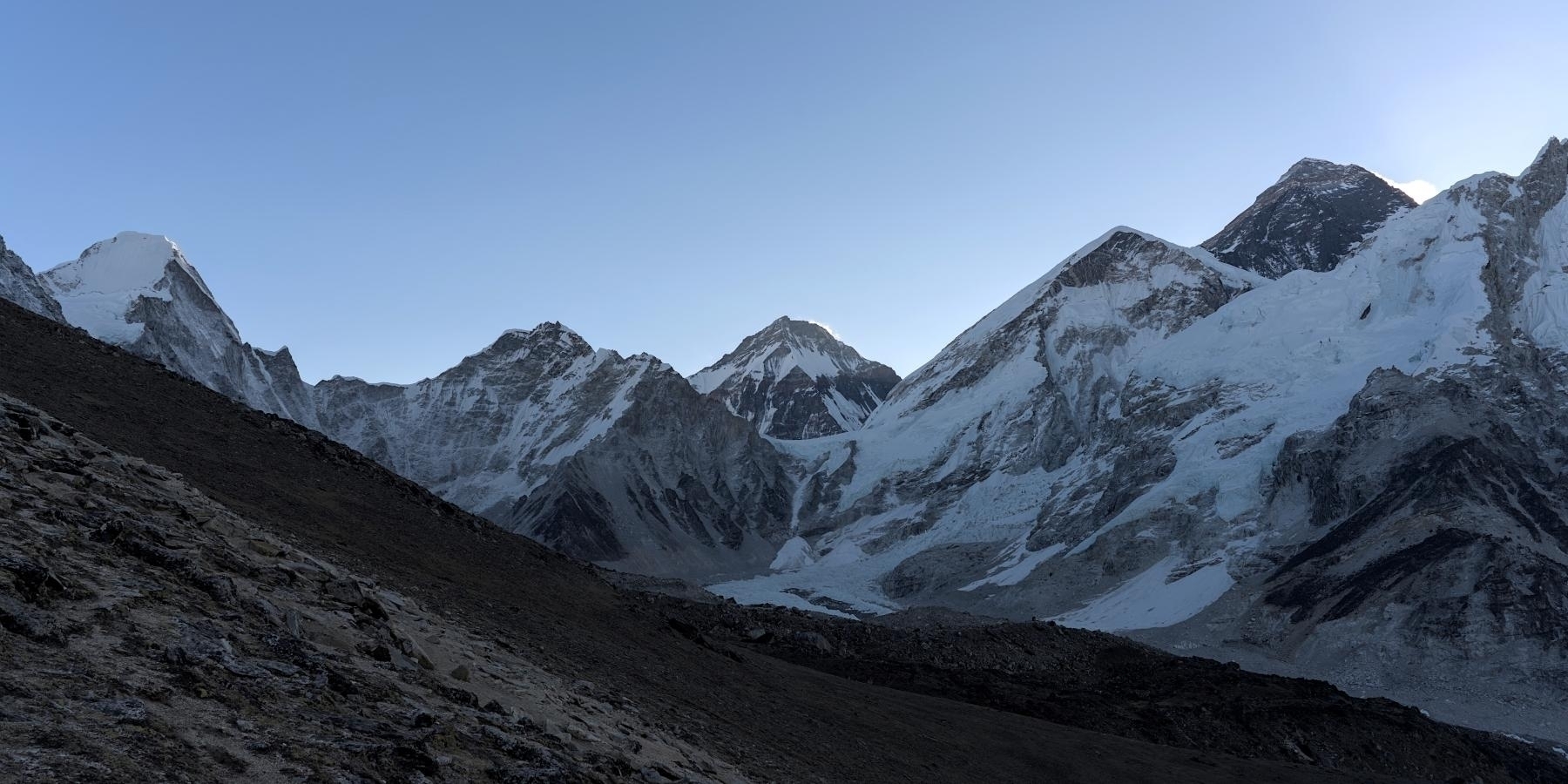
Mount Everest is often
referred to as the "King of the Mountains," and for good reason. At
8,848 meters (29,032 feet), Mount Everest is the tallest mountain on the planet
by a wide margin. And because of its height and well-known climbing history, it
is also the most famous mountain on Earth. While a visit to the summit of
Everest is too dangerous and difficult for most people, many would be surprised
to learn that a visit to Everest Base Camp, which sits at a more modest 5,364
meters (17,598 ft), is within reach of most. Everest Base Camp is a magical
place; a massive, mountain amphitheater overlooking a moving glacier,
surrounded by peaks of more than 7,000 meters, and boasting some of the most
incredible views on Earth.
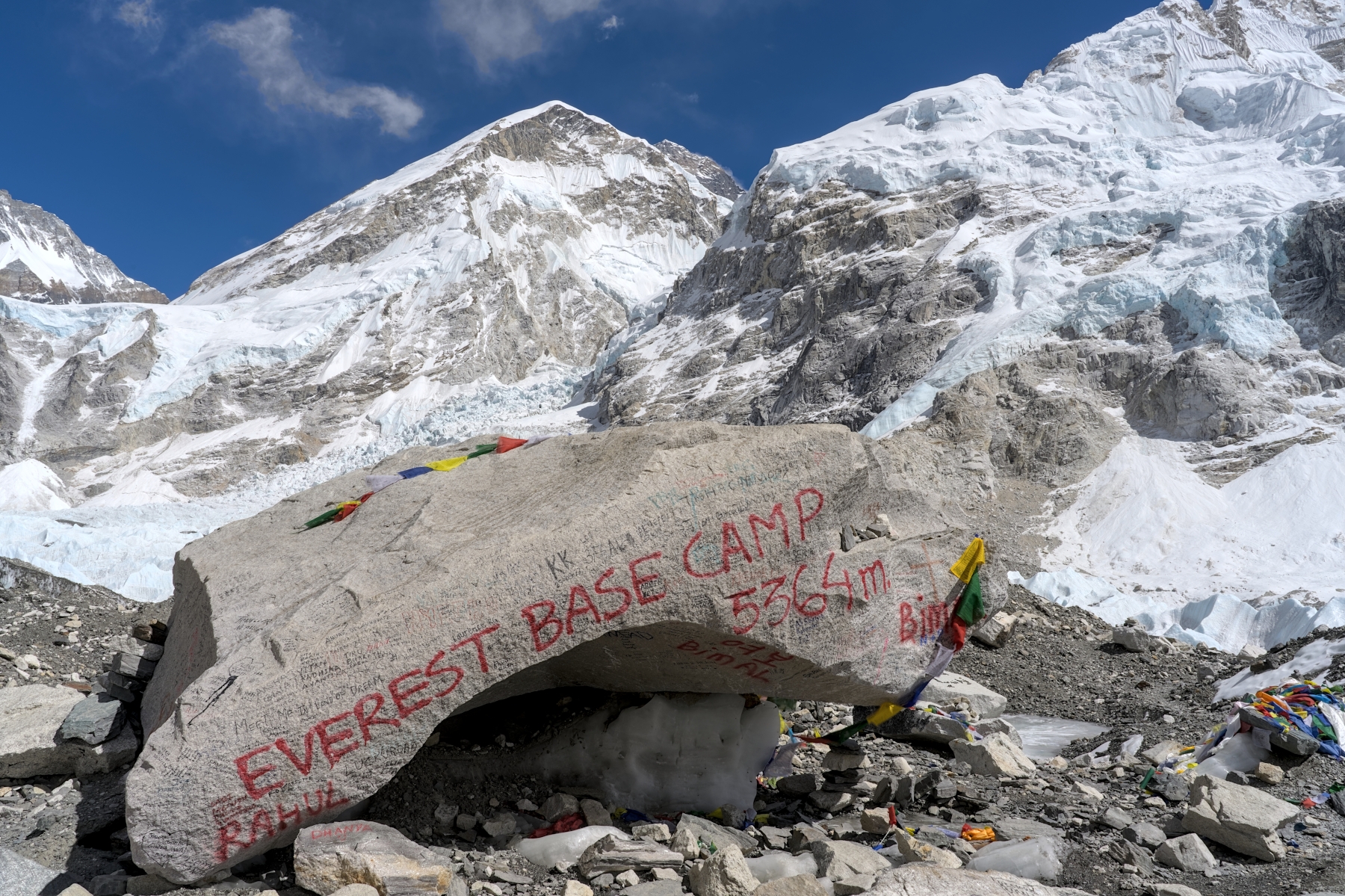 The famed Everest Base Camp rock,
with Mount Everest barely visible at top center
The famed Everest Base Camp rock,
with Mount Everest barely visible at top center
So why is it that less
than 30% of people who trek in Nepal visit Everest Base Camp? Nearly everyone
on Earth has heard of Mount Everest, and yet far more people who come to Nepal
see less famous mountains like Annapurna and Dhaulagiri instead. Do people
think that because climbing Mount Everest is so difficult and dangerous that
the trek to Everest Base Camp must be difficult as well? Are people afraid of
the flight to Lukla? Have people heard that that there are other treks in Nepal
that are better? Is it a mistaken belief that the EBC trek is overrated or just
not as good as other treks in Nepal?
This blog post will explore the reasons why, just as "Everest is the King of the Mountains," the EBC trek is the “King of the Treks” in Nepal. But for the TL;DR (too long; didn’t read) crowd, a brief summary at the beginning might help.
More than any other
trek on Earth, the EBC Trek will give you bragging rights. Sure, there are
longer, more difficult, more remote, and more epic treks out there. But tell
someone that you trekked Upper Dolpo, did the Kanchenjunga or Dhaulagiri
Circuit, or made it to Tilicho Base Camp, and you’ll be likely met with polite
stares and confused silence. Even better well-known treks like Annapurna
Circuit and Langtang Valley simply aren’t well-known to the general public. But
Mount Everest? Everyone knows about Mount Everest. If you tell someone you went
to Nepal, the first thing they will ask is: “Did you go to Mount Everest?” I’m
serious, that is ALWAYS the first question they ask. And when you tell them,
“Why, yes. Yes, I did” they will inevitably be impressed.
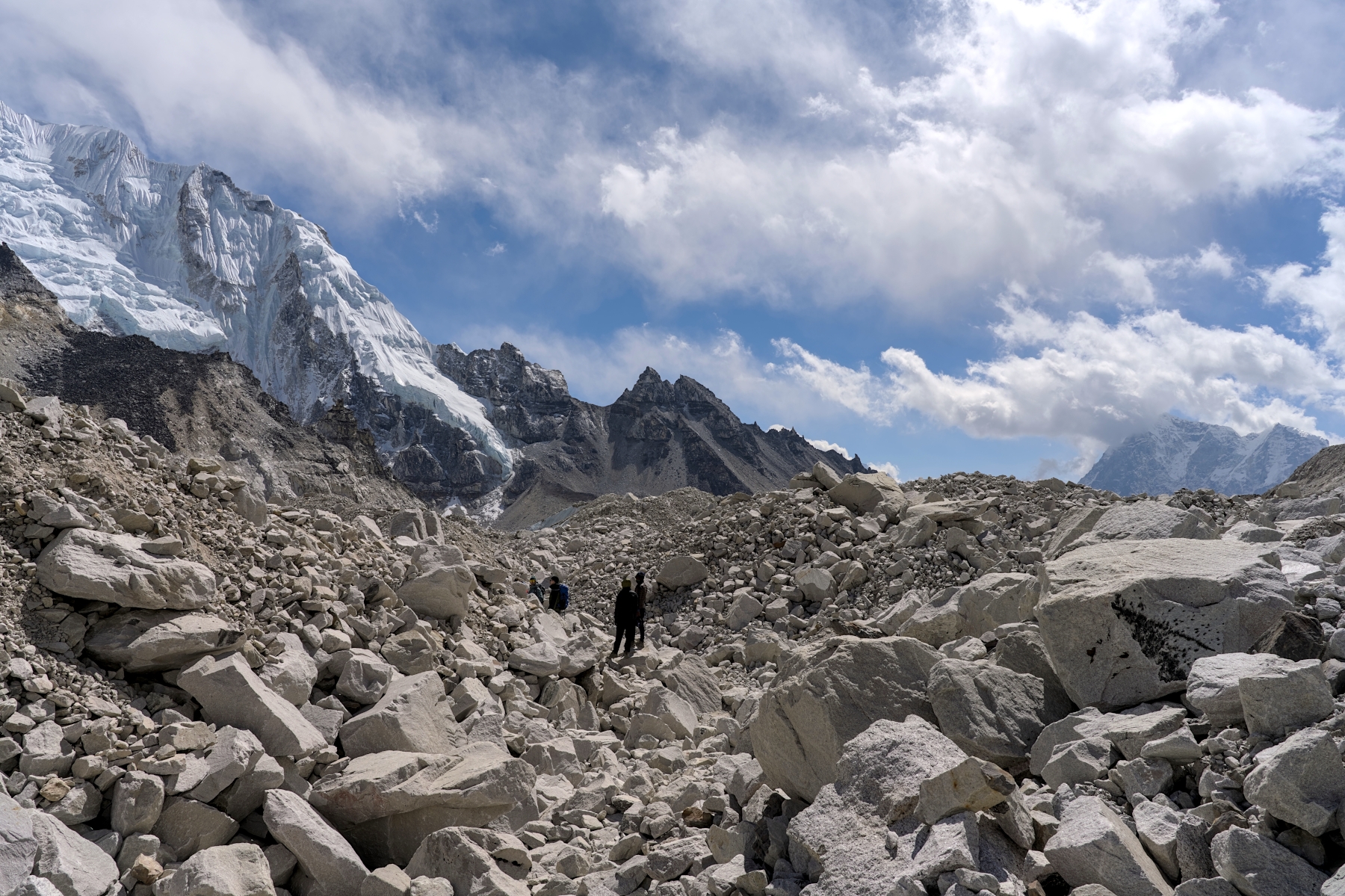
A bit of bouldering on the trail, about
a half hour’s walk from EBC
The EBC trek also does
a great job of striking a balance between challenging yourself and staying
safe. The EBC Trek is far from the easiest trek in Nepal, but it is also by no
means the most difficult. There are more difficult uphill climbs on the EBC
Trek than on most treks and there is a lot of elevation gain, but other treks
(such as the Annapurna Circuit) are more difficult. Aside from the Three Passes Trek (which itself is an offshoot of the EBC Trek), there isn’t a trek in Nepal
that brings trekkers to such high elevations for such a long period of time.
You’ll spend four nights in a row above 4,400 meters (14,436 ft), which is
higher than the highest point of most countries, however the trek gains
altitude steadily and gradually to allow time to acclimatize. And in case of
altitude sickness, the people of this region are so experienced in dealing with
altitude sickness and the helicopter rescue infrastructure is so
well-established that helicopter rescues, though rare, are almost routine at
this point. All told, for those interested in mountain climbing who want to see
how their bodies hold up to the challenges of climbing at high altitude, the
EBC Trek is one of the best and safest tests there is. 
The trekking trail at the Thukla
Pass, with Ama Dablam on far left
The EBC trek also
represents a great balance between wild, untouched natural trekking and
convenience. If constant cell phone service, fast Wi-Fi, regular hot showers,
private bathrooms, and reliable electricity are import to you, maybe the
Everest Region isn’t right for you. The trekking trail, especially in the upper
reaches of the trek, is raw and rugged compared with the roads and
well-manicured walking paths in the Annapurna Region. If you aren’t much of a
hiker and just want to see some mountains and check your emails and social
media regularly throughout the trek, trekking in the Annapurna Region might be
better.
But isn’t trekking
about connecting with nature? In the Everest Region, the lack of roads,
cellular service, and many of the amenities that seem to define modern life will
help you to appreciate nature for what it is. You won’t see roads, vehicles,
overhead power lines, or cell phone towers for nearly two weeks. You don’t know
how refreshing that is until you experience it. That said, if you’re feeling a
bit too disconnected, there is usually Wi-Fi and hot showers available for
purchase at the tea house, and although eating meat is a bad idea above Namche
Bazar, you can eat comfort foods like pizza, macaroni and cheese, and Mars Bars
throughout your trek. And every morning still starts with coffee or tea for the
caffeine addicts.
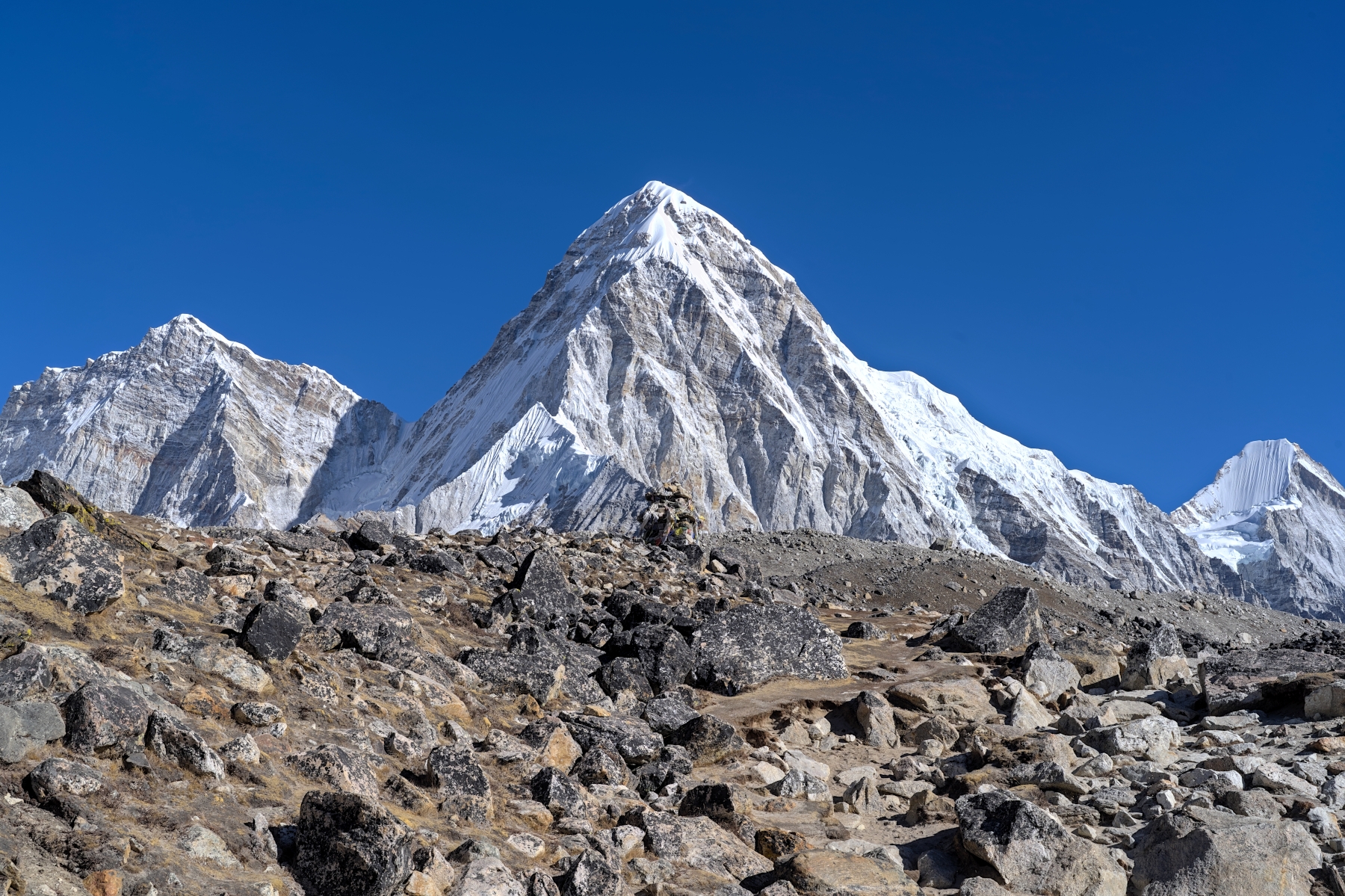
View of Pumori (7,161 m) from the trail between Lobuche and Gorak Shep
Finally, the EBC Trek has some of the best views Nepal has to offer. Seeing the Everest Massif and Ama Dablam from the Everest View Hotel while enjoying a cup of tea is guaranteed to give you one of the most satisfied smiles you'll ever have. Viewing the Dingboce Valley, with Makalu, Baruntse, Island Peak, and Lhotse glowing white in the morning sky is a view you might not have seen when researching this trek, but after seeing it, will wonder why it isn't more famous. The incredible, 360-degree views from the plateau atop the Thukla Pass will likely be the most breathtakingly beatufiul thing you've seen in your life up to that point. And that famous view from Everest Base Camp, with Lhotse, Nuptse, Changtse, Khumbutse, Lingren, Pumori, and of course Mount Everest towering above will be a view that you'll never forget.
Does this trek sound like something you'd be interested in? If so, feel free to read the more detailed, day-by-day description of the trek below.
One of the hardest
parts of the Everest Base Camp Trek is getting there. Mount Everest is a part
of Sagarmatha National Park (Sagarmatha is the Nepali name for Mount Everest),
which is in a remote area of Nepal. Although Lukla, the starting point of the
EBC trek, can be reached by road, the drive to Lukla from Kathmandu takes 20
hours in a cramped bus, driving on rough mountain roads. By contrast, the
flight to Lukla takes only 30 minutes. For this reason, nearly everyone who treks
in the Everest Region flies into Lukla.

Lukla airport in morning just
before the first plane departure of the day
Some travelers are hesitant to fly to Lukla because of how dangerous they’ve heard it is. Search online for "most dangerous airport on Earth” and nearly every list you'll come across will rank Tenzing-Hillary Airport in Lukla as #1. And it’s easy to understand why. This airport sits at 2,800 meters elevation and is surrounded by mountains on all sides. The runway is very short due to the surrounding terrain, with a mountain wall on one end and the edge of a cliff on the other. And although safety has improved considerably over the last decade or so, given the somewhat checkered safety record of certain Nepali airlines, this flight does present more risk than your average commercial flight. But tens of thousands of trekkers travel to the Everest Region every year with nearly all of them flying into and out of Lukla, so don’t let what you read on the internet dissuade you from doing the EBC Trek. The flight to Lukla will probably be the most beautiful flight you'll ever take, but it will DEFINITELY be the most memorable.
After the thrill of the
flight wears off, you’ll find yourself in Lukla, a quaint, hillside town that
serves as the gateway to the Everest Region. After a cup of coffee or tea at a
local teahouse, you will set off, walking along cobblestone paths and passing countless
trekking supply stores. At this point it begins to hit you: you're on your way
to Everest. After leaving Lukla, the trail becomes mostly hardpack dirt,
with some paved and/or stone sections, especially when going up or down. This
easy-to-navigate trail meanders along hillsides, through dense Rhododendron
forests and small villages, with the faint roar of the Dudh Koshi River below. This
portion of the trek is relatively flat (by Nepal standards), though there are
still some ups and downs. Trekkers typically stop for the day in Phakding, a
small village that spans the Dudh Koshi River.
View from “Mudslide Bridge” in
Chaurikharka, with Kusum Kanguru (6,367 m) in background
The next day the “Nepal
flatness” of the trail continues along the river until the afternoon, when the
first true climb of the trek begins. After crossing the famed Hillary Bridge,
with stunning views of the river and surrounding hills (and even Lhotse off in
the distance if the weather cooperates), the trail heads uphill towards Namche
Bazaar. This section of the trail rises approximately 600 meters in a
relatively short distance, making it steep and physically demanding. The trail
itself consists mostly of narrow, well-maintained, dirt covered switchbacks. Around
halfway up this hill section there will be a small clearing where, in good
weather, you will get your first glimpse of Mount Everest.
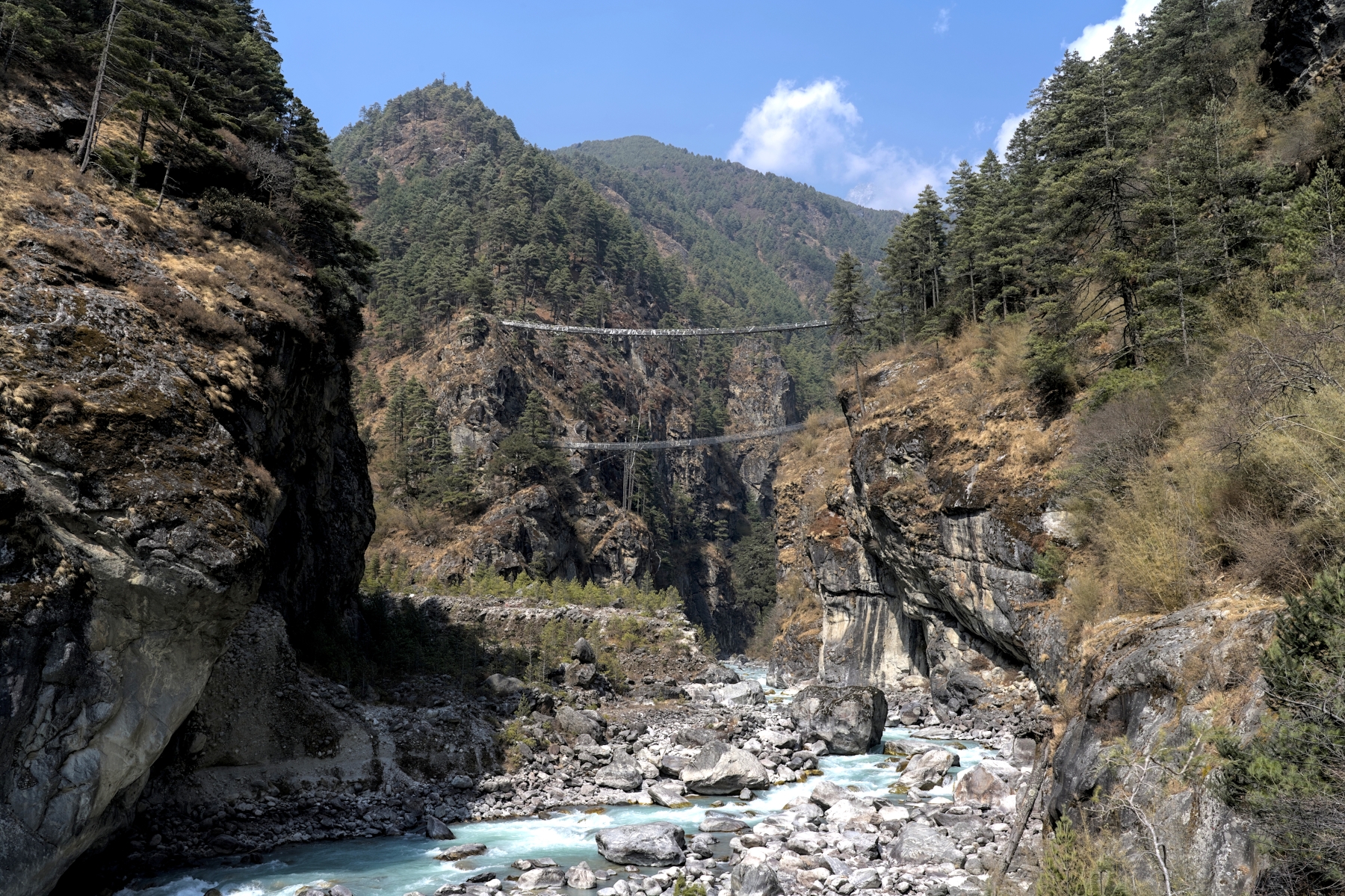
The new Hillary Bridge (top) and
old Hillary Bridge (bottom) taken from the riverside below
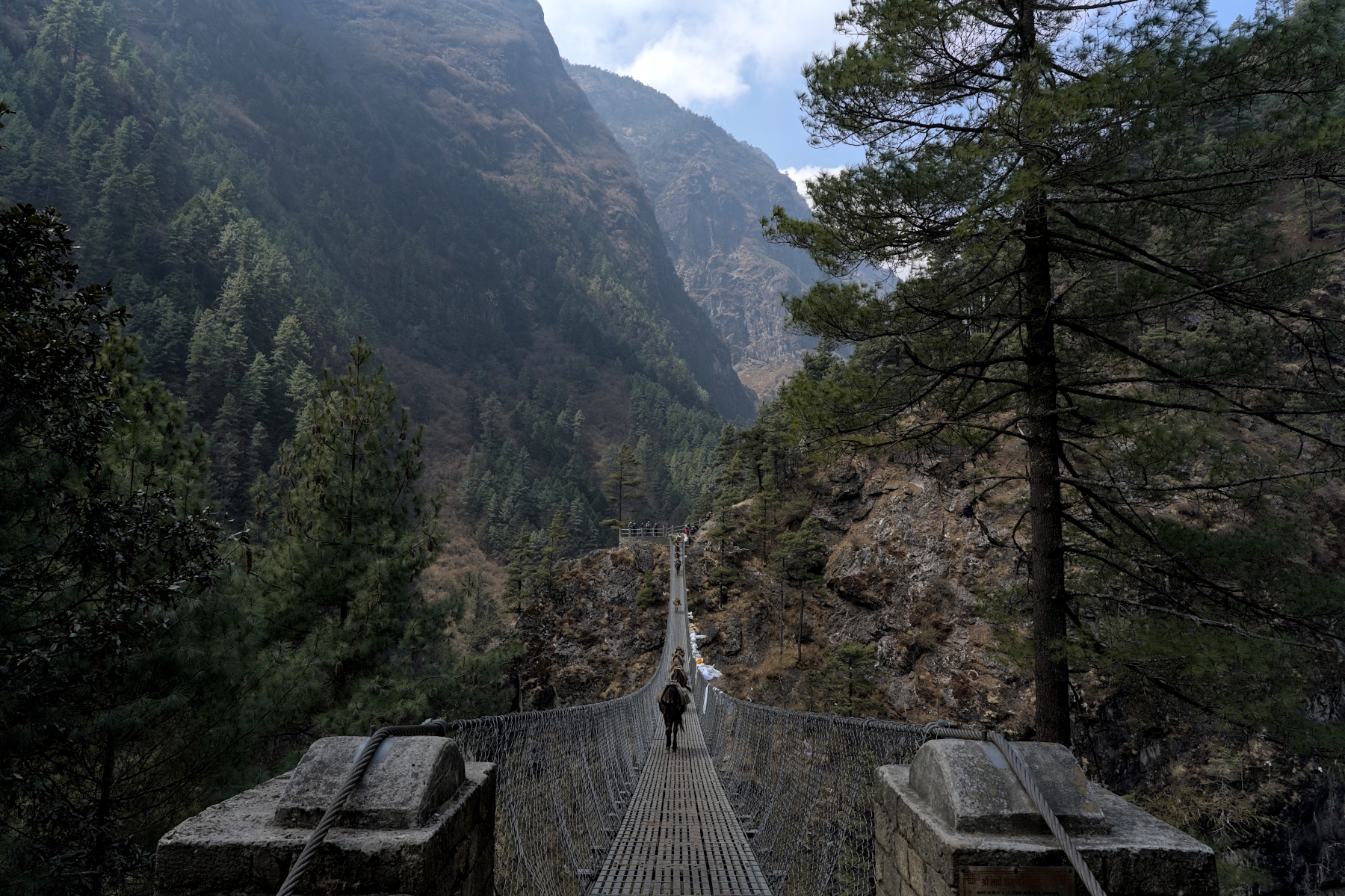
The infamous Hillary Bridge,
looking westward towards Namche Bazar
After a couple hours of
walking uphill the trail rounds a bend and the hillside town of Namche Bazar
appears above, like an amphitheater of teahouses and shops. Namche Bazar is over
2,000 meters higher in elevation than Kathmandu and around 800 meters higher than
the location of last night’s sleep, so a rest day to help acclimatize is a must.
Thankfully, unlike a lot of other acclimatization spots in Nepal which can be a
bit boring, there is a lot to do in Namche Bazar. It is full of cafes with all
kinds of delicious baked goods, quality restaurants serving a wide range of
cuisines from around the world, and even some bars to relax and unwind. While
alcohol should be avoided until you’re on your way back down the mountain, the
bars in Namche Bazar also sell non-alcoholic items and tend have free Wi-Fi, while
also playing documentaries/movies in the afternoon. Some bars have pool tables,
darts, and other games, and there is even a bar with live music!
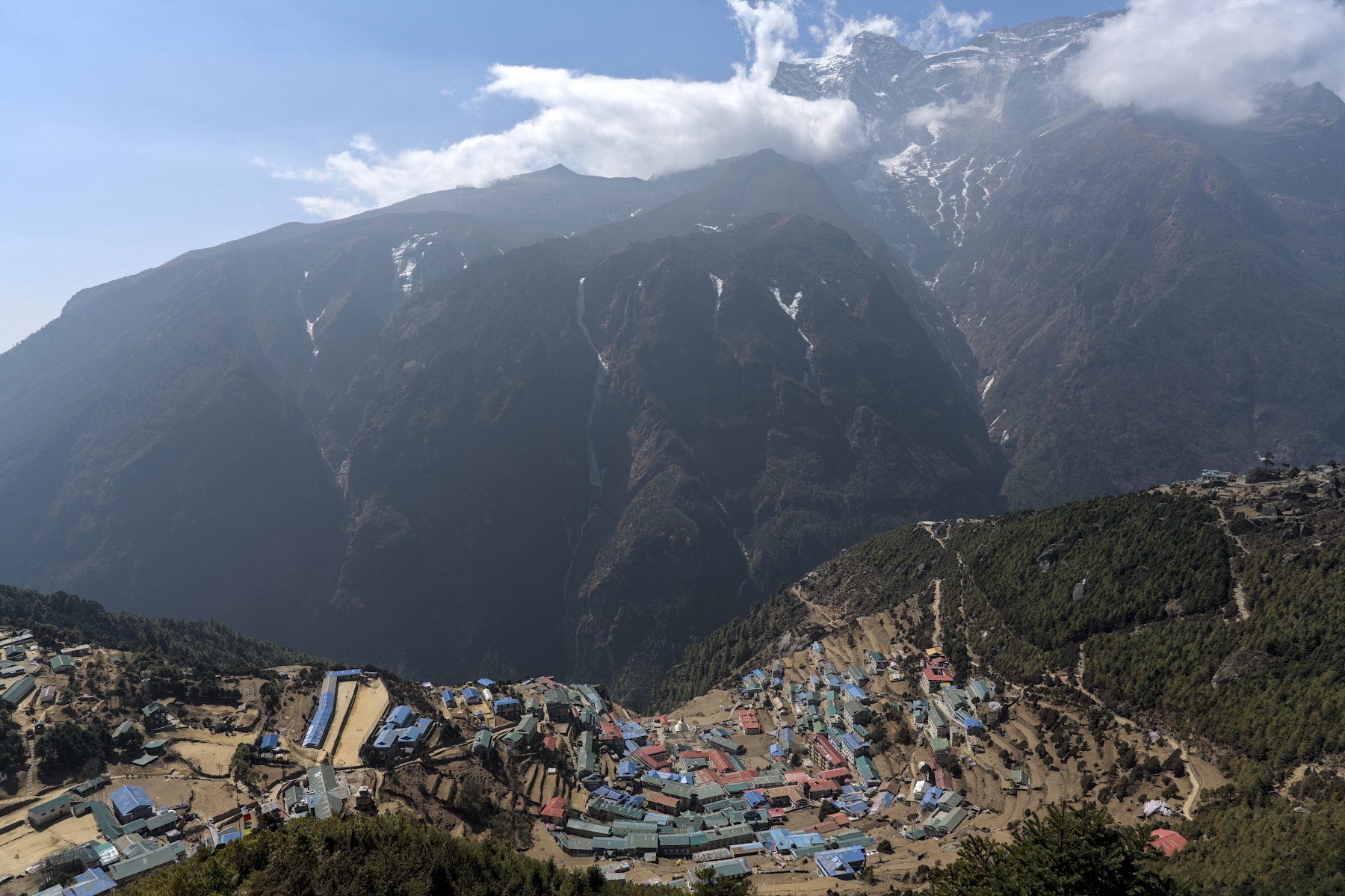
Namche Bazar from above. You will
see this viewpoint three times on your trek
After gaining 800
meters in elevation on the previous day, your body will need time to adjust. But
your “rest” day in Namche Bazar shouldn’t be a lazy one, because an
acclimatization hike is one of the best ways to cope with the altitude gain.
The maxim of “hike high, sleep low” is well-known in the mountaineering
community and it certainly applies to Namche Bazar. Hiking to a higher altitude
during the day and then returning to Namche Bazar to sleep helps far more with acclimatization
than simply relaxing in bed would. The two most popular acclimatization hikes are:
1) to the Everest View Hotel or 2) to Khumjung Village, both of which are
worthwhile trips.
Most trekkers choose to
hike to the Everest View Hotel, which is a luxury hotel located at nearly 3,900
meters altitude. The trail here is a fairly steep uphill climb along stone
steps and eventually a rocky, dirt path until it reaches a plateau above Namche
Bazar. Once the trail reaches this plateau, the rest of the hike becomes a
relatively flat and rather enjoyable walk. At the end of this walk is the
Everest View Hotel, a luxury hotel that boasts the title of being the highest
hotel in the world. The hike to Everest View Hotel is the most popular
acclimatization hike in Namche Bazar because at the end of the hike, trekkers
spend a half hour or so enjoying a cup of tea and a snack while admiring the
incredible views of Mount Everest, Lhotse, Nuptse, and Ama Dablam. Trekkers
return to Namche Bazar by the same route, with the trek typically taking 3-4
hours roundtrip to complete.

View from Everest View Hotel. Lhotse
is covered in clouds, while top of Everest (with clouds behind it) is in center
But for those looking
for something a bit more challenging and/or off the beaten path for their
acclimatization hike, Khumjung Village is a perfect alternative. Khumjung is
one of the largest Sherpa communities on earth where thousands of Sherpas live
year-round; farming the land, raising yaks, and of course acting as mountain
guides. Unlike the nearby Namche Bazar, this village is not a major stop on trekking
routes, and as a result, it shows Sherpa life as it has existed for centuries. Khumjung
is a beautiful place to stroll the narrow paths, admire the beautiful scenery,
and purchase local wares that benefit the community. And of course, a trip to
Khumjung wouldn’t be complete without a visit to the Khumjung Monastery, the
center of the local community, and according to legends, home to a real yeti
skull!
Khumjung village, with Khumbila
(5,761 m), a holy mountain for the Sherpa people, in the background
The trek to Khumjung is
a little bit longer and a bit more difficult, but if you’re really into hiking
and want to see real Sherpa life, I think it’s totally worth it. But regardless
of which acclimatization hike you choose, you be back in Namche Bazar around
lunch time, after which the rest of the day is yours to enjoy. Do some
shopping, have a cup coffee and a local pastry, or my favorite: enjoy a
documentary about the Himalayas in one of the local bars such as Yeti Bar or
Liquid Bar. The documentaries usually relate to Mount Everest and mountain
climbing, with common showings including: Into Thin Air, Sherpa, and The
Conquest of Everest.
Watching one of these documentaries at 3,400 meters elevation on your way to EBC really hammers home their message and will leave you feeling awed. And although drinking alcohol is a big no-no on your way up the mountain, these bars are also quite happy to serve you tea and snacks instead. Whatever you choose to do in the afternoon, be sure to eat a good dinner and get to bed early so you’re rested and full of energy for the next day’s hike.
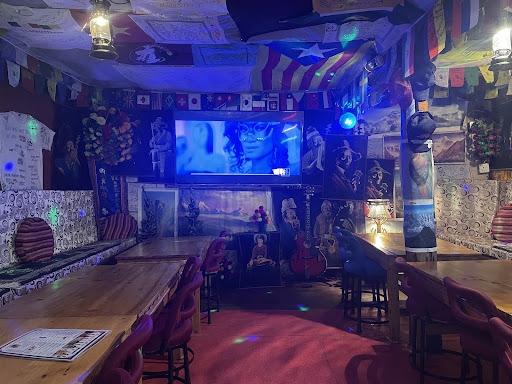
Typical view from inside a local Namche
Bazar Bar
The following morning
the trek continues towards Tengboche. After climbing the hill to join the trail
above Namche Bazar, the first two hours or so of the trek will be quite
enjoyable. Once again, this section can be described as “Nepal flat,” with some
ups and some downs, but for the most part even terrain. The trail in this
section is mostly packed dirt with some stone stairs, hugging the side of hills
and mountains overlooking the Dudh Koshi River. While hiking this section,
incredible views Mount Everest, as well as Lhotse, Nuptse, and Ama Dablam are
ever-present in front of you. The only thing that will slow you down on this
easy section of trail is stopping to take photos as you round every bend.
Unfortunately, while
the first half of the trek is relatively flat and easy going, the second half
is anything but. After 2-3 hours of hiking the trail heads downhill towards the
Dudh Koshi River, around 500 meters below. The trail in this section is steep
at times and consists of many dirt switchbacks through dense forests. The dirt
in this section is rather loose in contrast to the hardpack you encountered
earlier, and it can be quite slippery in wet weather or when covered in tree
needles and other debris. That said, this section can also be quite enjoyable (unless
you have bad knees). Eventually the trail reaches the river, which is the
perfect spot to stop for lunch.
After eating, there is
a good chance it will dawn on you: “Tengboche is around 400 meters higher in
elevation that Namche Bazar.” You will then likely remember the hike so far,
and will think to yourself, “I feel like after that downhill section before
lunch, I’m at a lower altitude than I was when I started my hike.” And you would be correct. The altitude as you
cross the river toward Tengboche is more than 100 meters lower than Namche
Bazaar, which means you’ve got around a 500-meter climb ahead of you. This
section of will feel a lot like the hike from the Hillary Bridge to Namche
Bazar from two days earlier; walking steadily uphill along dirt and rock
switchbacks, with a canyon and river to one side and a hill, on top of which is
your destination, on the other. But
after a few hours you reach the top of the hill, with the Tengboche Monastery
to your left and Mount Everest in front of you off in the distance.

Tengboche Monastery in mid-morning
By the time you reach Tengboche, the clouds will have likely moved in and there won’t be much to see. But don’t worry, the weather in the morning is usually nice here, plus you will pass by here again on your way back down from EBC . In other words, you’ll have better chances of seeing the amazing view from Tengboche later in your trek. Assuming you aren’t too tired after the day’s hike, I’d recommend dropping your belongings at your teahouse and heading over to the Tengboche Monastery. Photographs aren’t allowed inside the inner parts of monastery, but sitting down in a corner, watching and listening to a roomful of monks praying and banging drums in their winter robes is a cool experience.
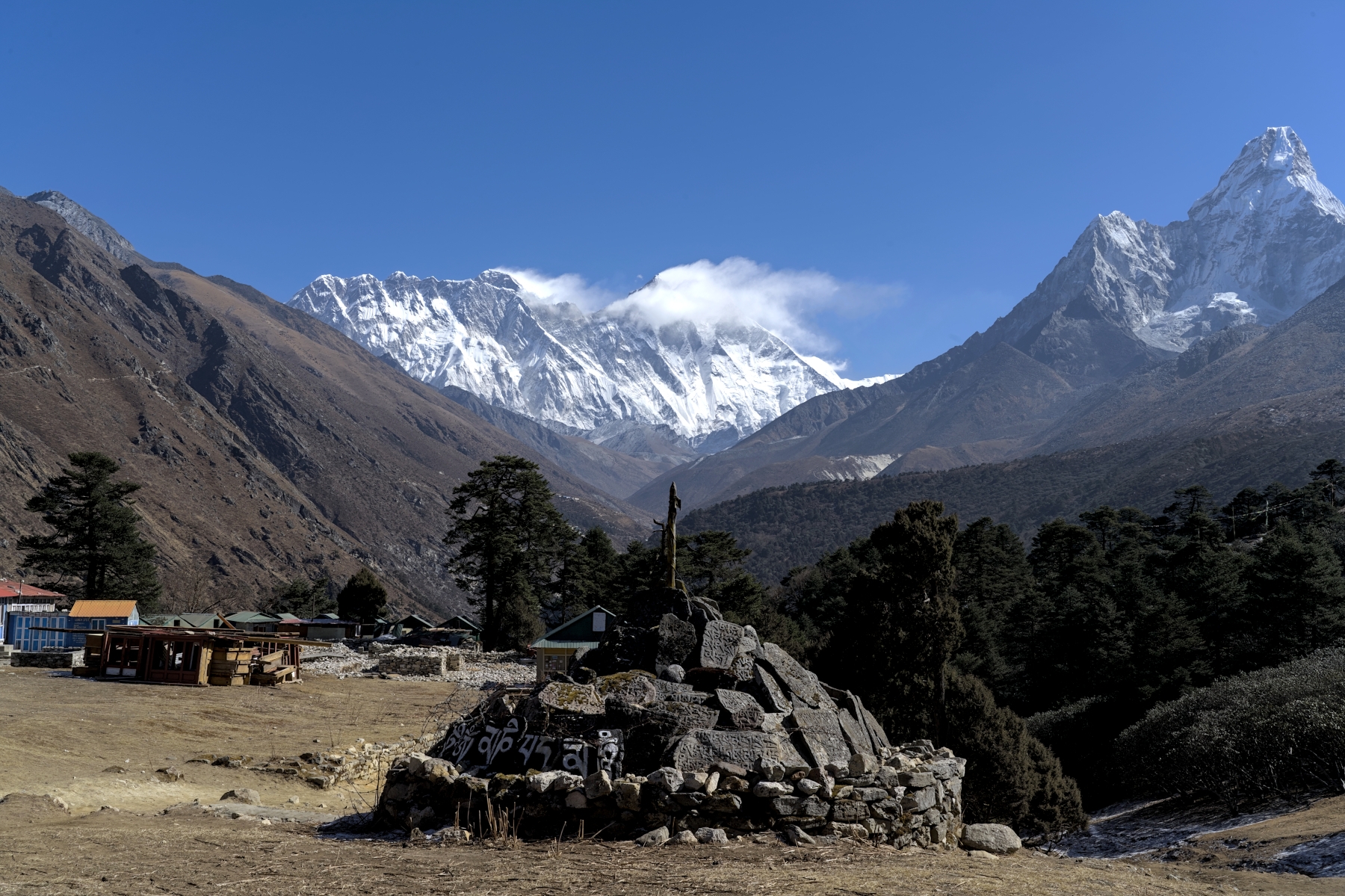
View from Tengboche. Ama Dablam
(right) and Everest (middle left), with Lhotse behind clouds
The following morning
the trek begins with one of the best “views from the starting point of the hike”
in the world. After appreciating the early morning beauty of the Everest Massif
and Ama Dablam, the trail heads downhill and meanders through dense forests,
with plenty of trees but very few views to speak of. However, this section is
relatively short, and in less than an hour the trail will reach a suspension
bridge that crosses the Imja Khola River.
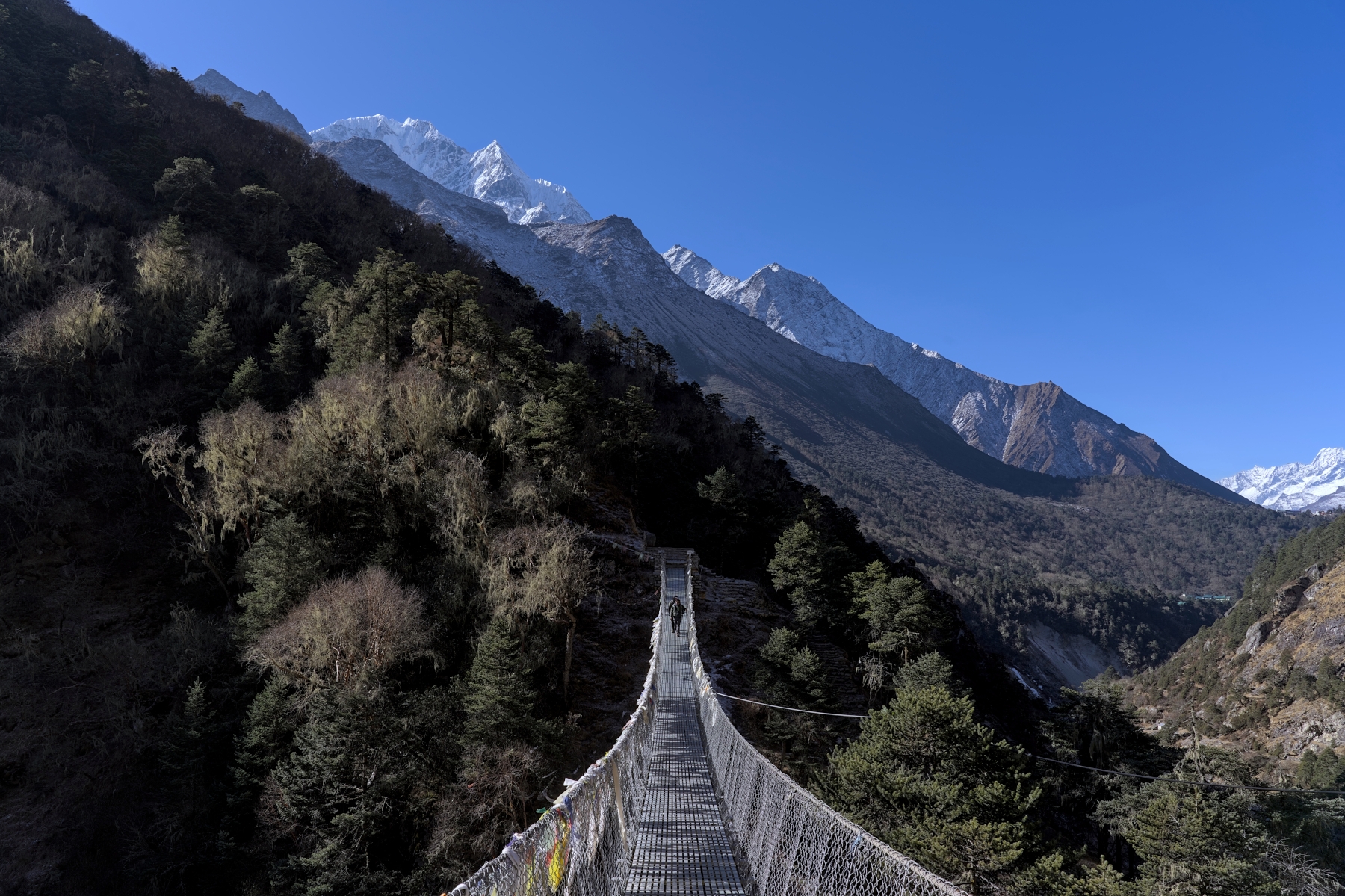
Imja Khola bridge looking East. Deboche
(lower right) and Tengboche (far right) visible from here
Once on the other side
of the river, the trail will feel remarkably similar to the morning portion of
the hike from Namche Bazar to Tengboche. Once again, the trail hugs the side of
hills and mountains, with the Everest Massif and Ama Dablam in front of you,
and a river (this time the Imja Khola and not the Dudh Koshi) below you to your
right. The trail is a bit less flat than the morning portion of yesterday’s hike,
but it’s still an easy, gradually uphill hike along a mostly hardpack dirt and
stone trail. There are few small settlements along this trail, so stop for
lunch whenever you get hungry. I’d recommend Shomare, as it splits the day up
nicely and leaves you some time to digest before reaching the river, where the
trail begins to get more difficult.

View of Lhotse (8,516 m) from the
trail between Tengboche and Dingboche
Eventually the trail
will begin to head back downhill towards the river. You might be thinking: “Not
again! Why am I going down when Dingboche, the next stop on the trek, is around
300 meters higher than here?” I’ve been frustrated more than once during this
section of the trail, but don’t worry, it isn’t as bad as it the day before! This
time the trail only loses around 150 meters of altitude before reaching the
river, and the climb from the river to Dingboche is easier than the climb the
day before. Once the trail crosses the river, it takes on a now-familiar form:
a hardpack dirt/stone path hugging the side of a hill, with a river below and
to the right and mountains on the other side of it. Fortunately, this is the
last time on this trek that the trail can be described this way (unless you
consider 6,000+ meter mountains to be “hills” and the Khumbu Glacier to be a
“river”). This is also the last point in the trek where you will see trees, as
the remainder of the trail to EBC lies above the tree line!
After an hour or so the
trail will level out and lead to a bowl-shaped valley with rolling hills
weaving their way through it. In the late afternoon, this valley tends to be
quite cloudy, as it is a confluence of three valleys; one heading east towards Island
Peak, Baruntse, and Makalu, another heading north towards Everest, Lhotse, and
Nuptse, and the third heading back towards Tengboche and Namche Bazar. If
you’re lucky, the weather will remain clear and you’ll see some incredible
views, otherwise you’ll have better opportunities over the next two days to see
this area in good weather.

Lhotse in early afternoon on a day
with good weather. Tingboche is just beyond the hill
After gaining
approximately 600 meters in altitude since leaving Tengboche (and nearly 1000
meters since leaving Namche Bazar), an acclimatization day in Dingboche is a
good idea. Although the choices for acclimatization hikes in Dingboche aren’t
as good as in Namche Bazar, once again there are two main options. The first
option, taken by around 99% of trekkers, is a hike up Narkang Hill. Also
sometimes referred to as Nakarsang and Nangkartshang, this hill looms over the
north side of the valley where Dingboche is located. Few trekkers climb to the
actual peak of this hill, which is approximately 600 meters above Dingboche;
instead, most hike anywhere between 200 and 400 meters higher. Remember, the
purpose of this hike is acclimatization, so while you don’t want to stop too
early and not get the benefits of higher altitude, you also don’t want to push
yourself too hard and develop or exacerbate symptoms of altitude sickness.
Listen to your body, and stop when you feel like you are starting to get tired.
The trail consists of
sections of hardpack dirt, loose gravel, and rocky terrain, and although the
trail is easy to navigate, it gains elevation quickly. You will feel like you’ve
walked up many flights of steep stairs, and flat portions to catch your breath
are few and far between. Take your time and stop if you need to; this is a
short day of hiking so there is no need to rush. Unlike most of the trekking so
far, the trail in this section isn’t linear, meaning there are a variety of
paths to follow up the hill. This is largely because the “trails” on this hill
are actually yak trails, carved into the mountain over many years as these
heavy animals climb the hill in search of plants for grazing. While some enjoy
having options as to which trail to take, others might get a bit nervous about
which trail to take. When in doubt, follow your guide, or if you are trekking
without a guide, just follow the crowds. It’s almost impossible to get lost
here!

View from midway up Narkang Hill. The
bottom reaches of Ama Dablam can be seen on the far left
Aside from being
important to your acclimatization, this hike is great because it offers some
incredible views! The views over the last few days, though objectively
fabulous, were likely starting to get a bit repetitive. The Everest Massif in
front of you, a chain of smaller hills and mountains to your left, a river
below you to your right, with Ama Dablam beyond it… as lovely as that view can
be, by this time in the hike you’re probably wanting a change of scenery. You’ll
get it here, with views of Ama Dablam from the opposite side as you’ve been
experiencing thus far, as well as all the mountains that were behind you as you
hiked to Tingboche. The foreboding South Wall of Lhotse can also be seen from this
hill, and as you scan to the right you will see other beautiful mountains,
including Makalu, the 5th tallest mountain on Earth at 8,485 meters,
and Island Peak, a popular trekking peak. 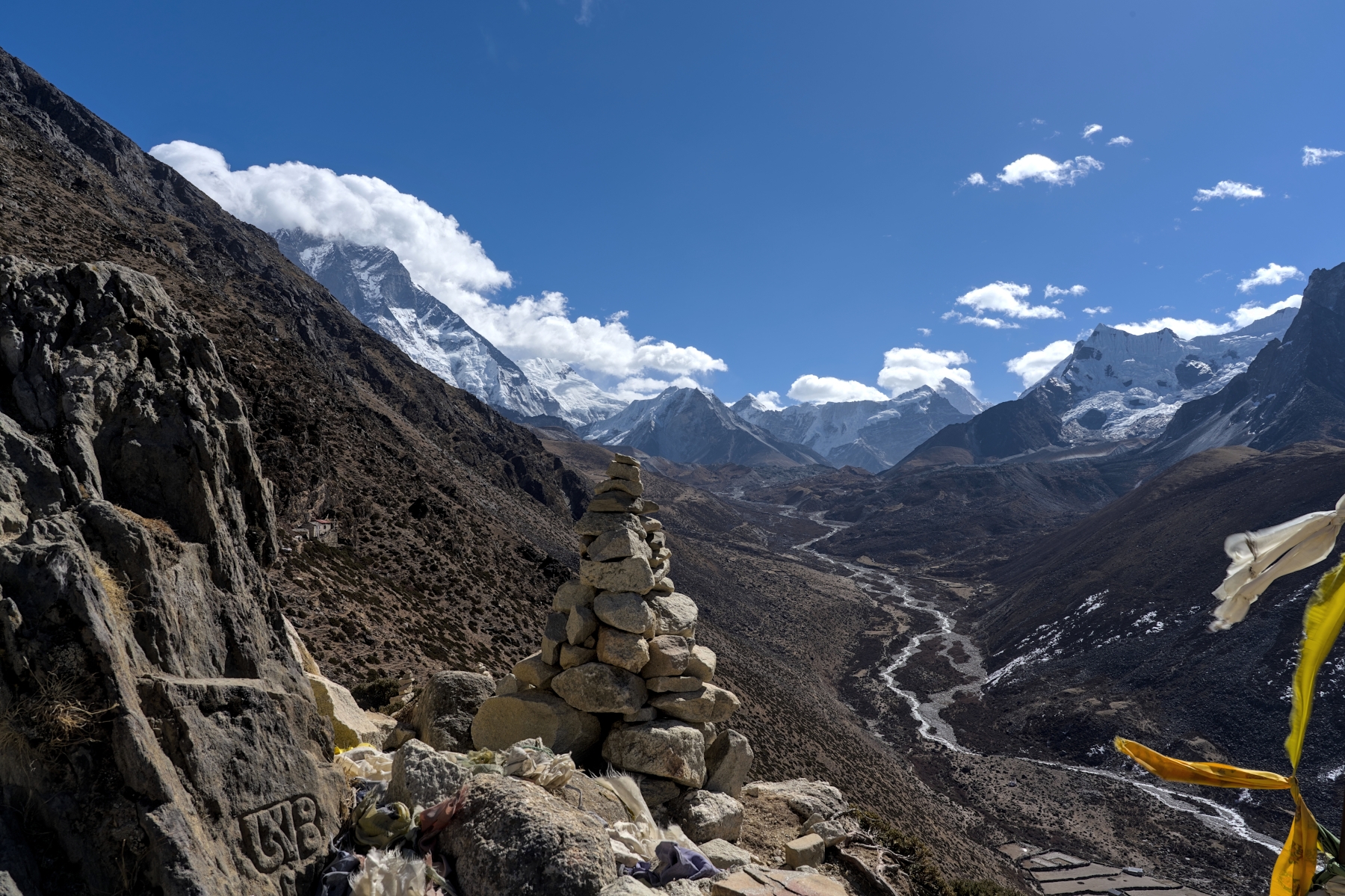
View from Narkang Hil looking east.
Island Peak (center) and Makalu (8,485 m) to its right. Lhotse (left) behind
clouds
The other, far less
popular option for an acclimatization hike is a walk towards Chukhung. Chukhung
is a small settlement at approximately 4,700 meters elevation, and is a stop on
the legendary Three Passes Trek as well as the last stop before Island Peak
Base Camp. Chukhung is a very unremarkable location that exists solely to cater
to trekkers and mountain climbers, so hiking the 3-4 hours that it would take
to get here is not worth it. But after hiking for around 2-2.5 hours, you will
reach the Jerzy Kukuczka Memorial, a small stone monument dedicated to the
second man to climb all fourteen 8,000-meter peaks. Behind this memorial is the
South Wall of Lhotse, where Kukuczka tragically lost his life in 1989. After
learning about Kukuczka’s life, seeing this monument, with Lhotse in the
background, is a beautiful yet somber reminder of the power of these mountains.
And though the hike here is a bit longer, the trail is more even and the
elevation gain is far more gradual than the hike up Narkang Hill. 
The Jerzy Kukuczka Memorial, with
the South Wall of Lhotse looming in the background
Either way, after your
hike you will return to Dingboche and spend the whole afternoon relaxing and
preparing for the hike to Lobuche the following. Make sure to get a good
night’s sleep, because come tomorrow, you are in for a treat. That’s because
the trek from Dingboche to Lobuche is, in my humble opinion, the best day of the
trek. Full stop.
The hike begins by
climbing a small hill that leads into a long valley, with the massive, 6,000+ peaks
of Tobuche, Tabuche, and Cholatse on the left, Pokalde Peak and Narkang Hill on
the right, and a small stream running down the middle. The trail in this
section isn’t clearly defined, as it consists of narrowing yak trails weaving
their way through the dirt, moss, grass, and sage brush covered ground. At
first, just like the Narkang Hill climb from the day before, the trail is
non-linear, and you might see other trekkers higher up the hill to your right
or closer to the stream on your left. Don’t worry, there is more than one path
in this section and as long as you keep heading up the hill to the right of the
stream, you can be sure that you’re heading in the right direction.
View of the valley heading towards
Lobuche (right) and Gokyo (left)
Eventually these yak
trails will combine and will lead to a single, hardpack dirt trail which
continues through the valley, steadily gaining elevation. The trail passes cozy-looking,
stone huts used by yak herders as they allow their herds to feed in this area
during certain seasons. These stone huts, with their stone walls and pens, when
juxtaposed against the harsh mountain background make for some evocative (and
beautiful) photo opportunities. 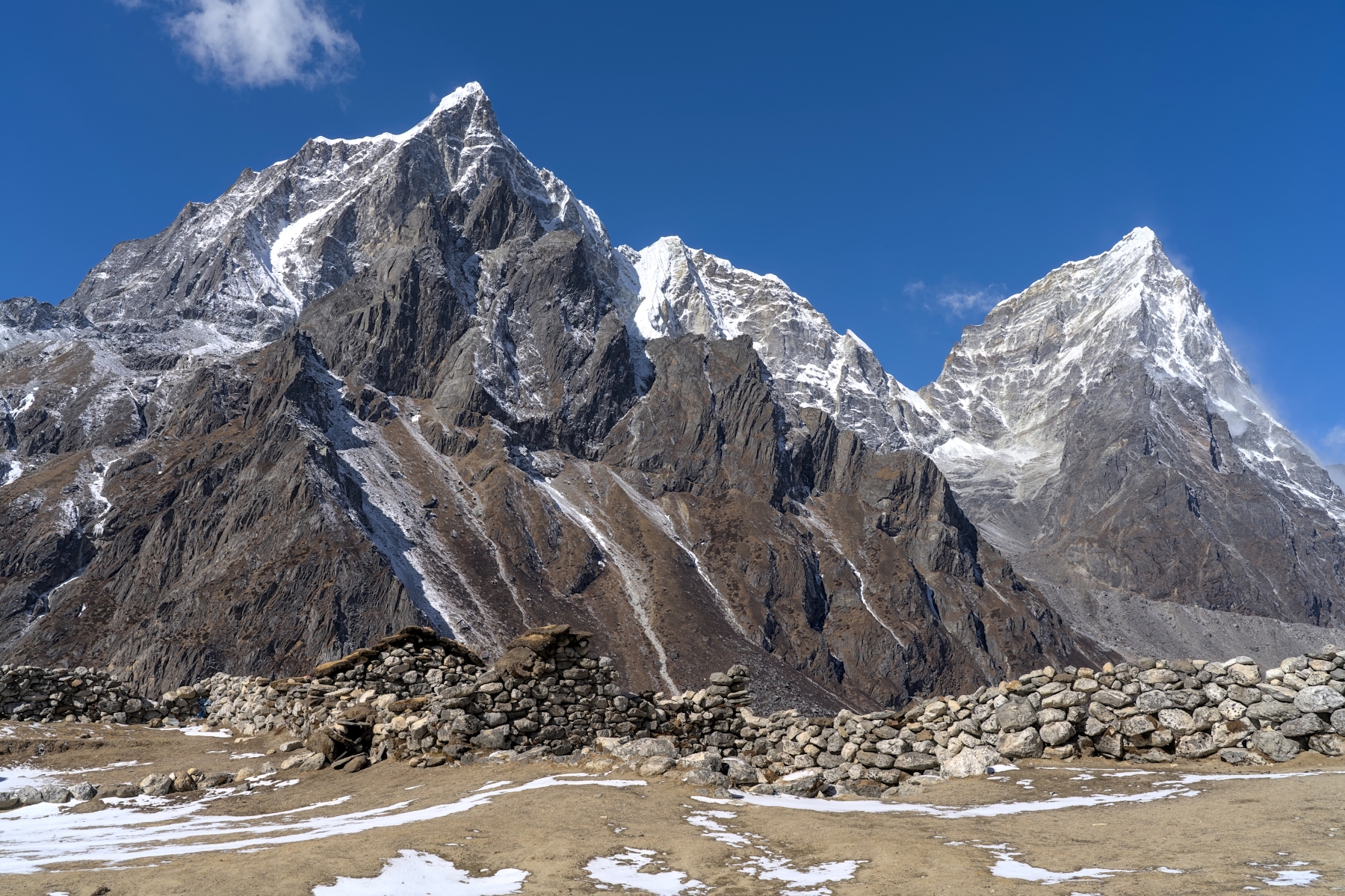
Tabuche (left – 6,495 m) and
Cholatse (right – 6,501 m), with small yak herder hut in foreground
As the hike continues
uphill, the trail and the terrain will get a bit rockier, and the scenery a bit
more rugged as the grass and brush become more rare and less dense. Eventually
the trail reaches Dughla (also known as Thukla), a small settlement that exists
solely for trekkers, as it sits at the confluence of the EBC Trail and the
trail between the Kongma La and Cho La passes on the Three Passes Trek. Thukla
is extremely small, consisting of a few basic teahouses, but what it lacks in
size it makes up for in scenery. This is essentially the only place where food
can be had between Dingboche and Lobuche, so everyone stops here for lunch and
to refill their water.
After lunch the trail
leads uphill to the Thukla Pass (or Dughla Pass, take your pick). This is a
steep, uphill climb along dirt and gravel switchbacks for what seems like an
extremely long time. As much as this section can be a bit tiring, due to the steep
nature and the relatively thin air, the trail itself is in good condition. If
you start to get tired, just stop for a second and gaze back down the mountain,
where you will see a stunning, unbroken chain of mountains along the horizon.
That will get your spirits up for more climbing. 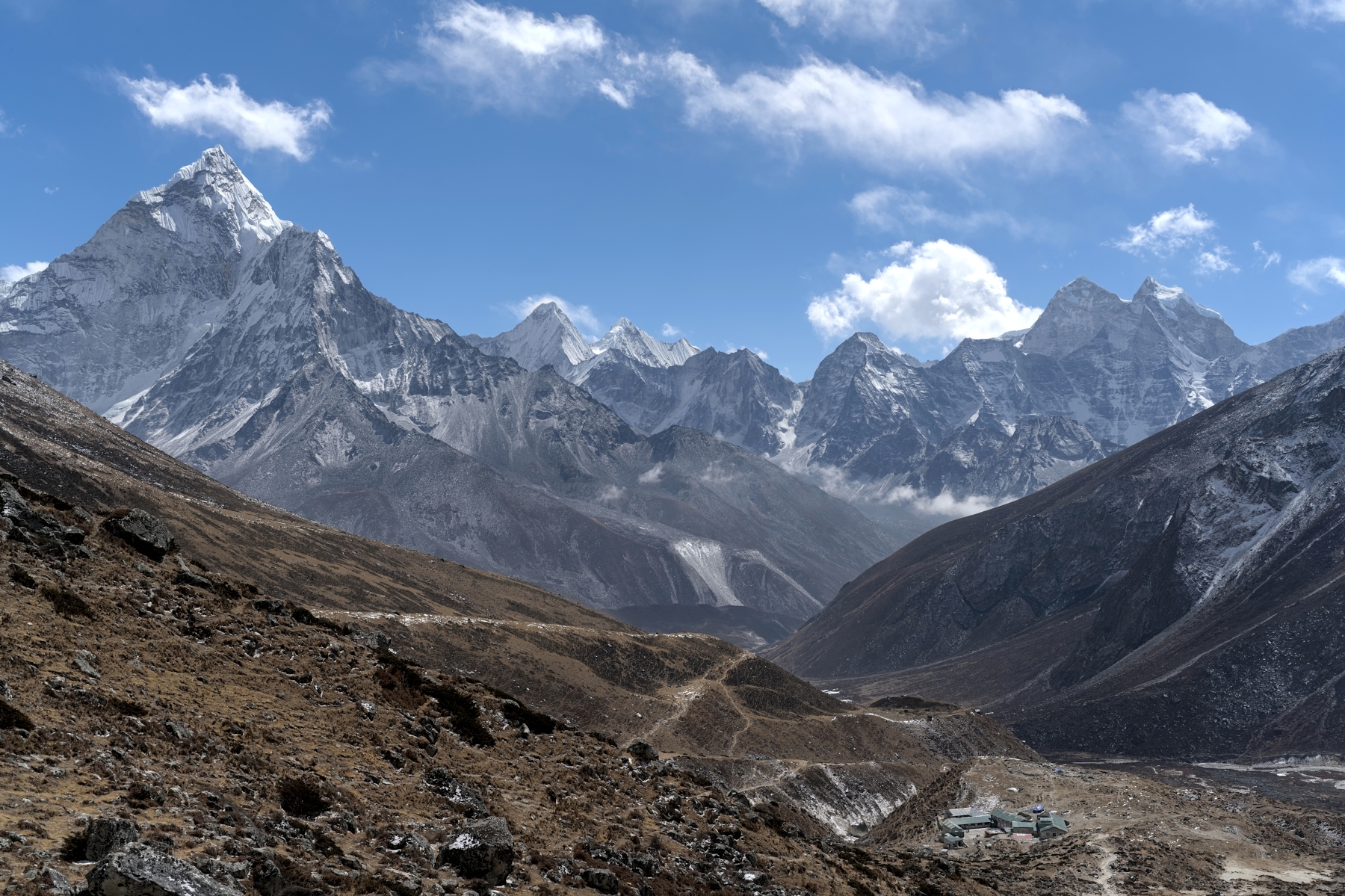
View looking south from nearly
halfway up the Thukla pass. Thukla is the small village at bottom right
After around an hour of
climbing, the trail reaches a plateau. But this isn’t your average plateau,
this plateau is a valley that is also home to countless memorial stupas for
climbers and Sherpas who lost their lives on Everest. The sight of hundreds of these
stone monuments is a chilling reminder of the power of these mountains and the
dangers they pose to anyone attempting to conquer them. Each of these memorials
has a heartbreaking story behind it, from memorials to well-known victims like
Scott Fischer, Rob Hall, and the others who perished in the 1996 Everest
disaster, to memorials for those known only to their families and the
mountaineering community. Each of the stupas here has a story to tell, and
although here is no cellular or internet service here; by taking some photos of
the memorials on your phone you can read about them once you’re back in
Kathmandu. 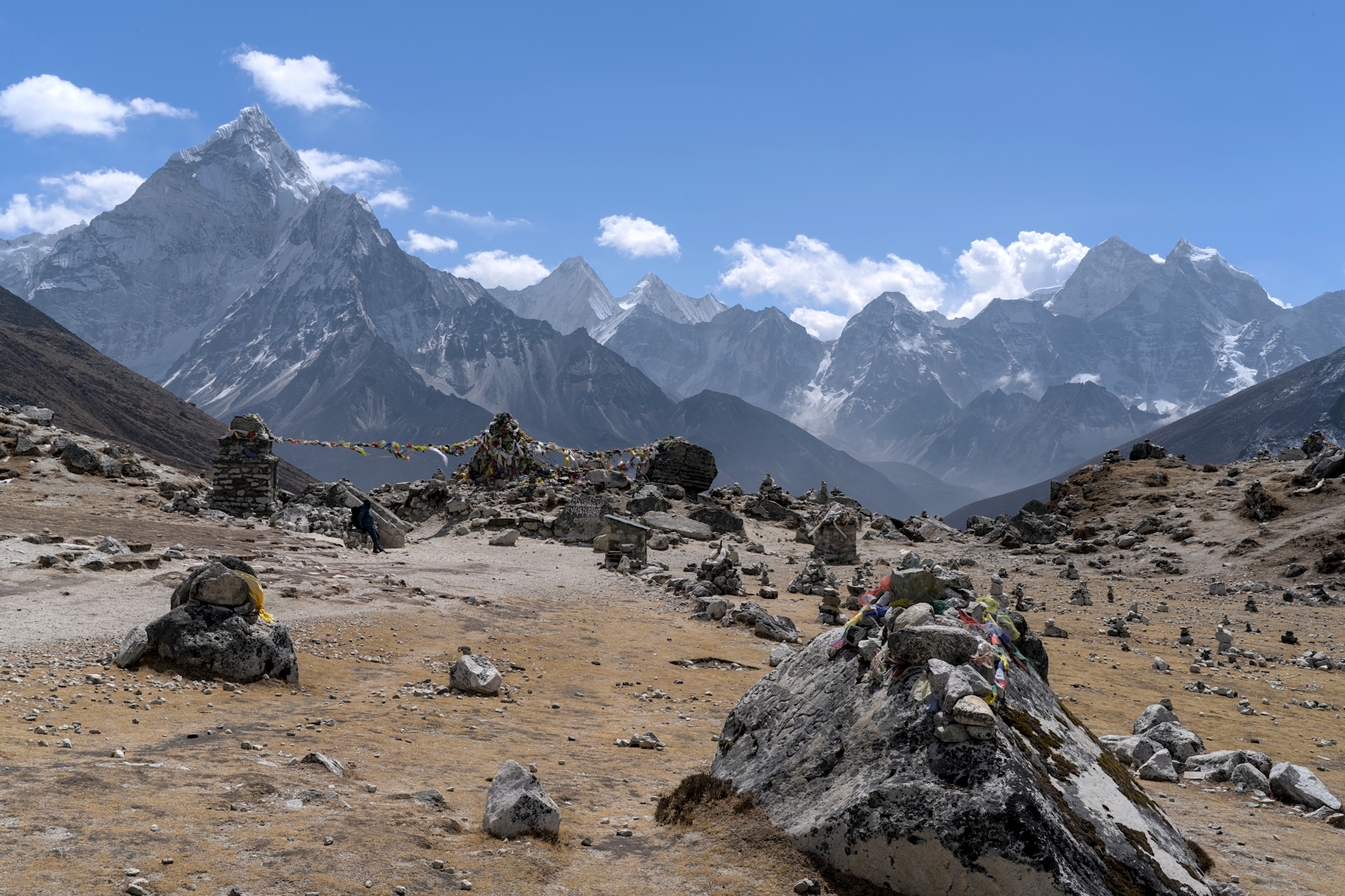
View of memorial stupas and
mountains from the Thukla Pass. Ama Dablam is the mountain at far left
Although all the
memorial stupas might give this plateau a somber vibe, you would be forgiven
for not feeling it because of the incredibly beauty of this place. Look down
the mountain in the direction of Dingboche and there is an incredible wall of
mountains, with the incomparable beauty of Ama Dablam looming on the left end
of the wall. To the right of the wall are the beautiful peaks of Tobuche, Tabuche,
and Cholatse, towering over the valley below. Turn around, and you will see for
the first time Pumori, a stunning, 7,161-meter mountain shaped like a pyramid,
with the even more interestingly shaped Lingtren beside it to the right and
Khumbutse beside that. These three mountains form the western part of the
Everest Massif and are connected to Mount Everest, along with its neighbors
Changtse, Nuptse, and Lhotse, via the western ridge and the Rongbuk Glacier. Unfortunately,
Nuptse, Lhotse, and Mount Everest aren’t yet visible yet, but after seeing some
of the other neighboring mountains for the first time, you know they’ll be
visible soon enough it. Every direction you turn on this plateau, you will see
some of the most beautiful scenery imaginable. It is, in my humble opinion, the
most beautiful place in Nepal. 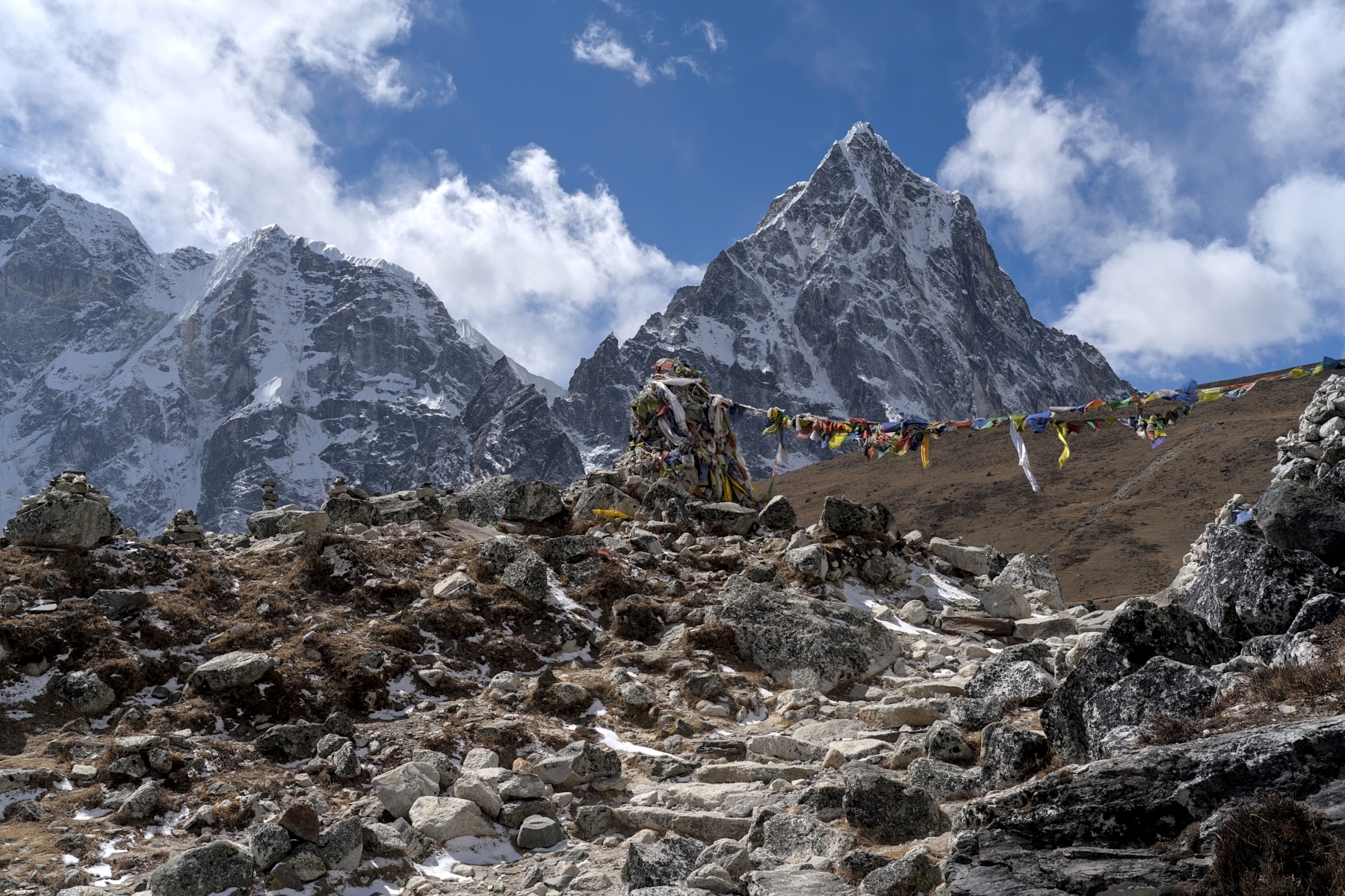
Memorial Stupa with prayer flags.
Cholatse and Tabuche in background
After spending time taking photos and admiring the views, the trek continues up the hill towards Lobuche. As the trail leaves the plateau it becomes hardpack dirt with a thin layer of loose gravel, with a few rocky sections here and there. In this section the trail is well defined and quite flat, as it weaves through a valley that was carved by a now-receded glacier. There are a few sections where the loose gravel can be a bit slippery, but overall it’s a quick, easy, and enjoyable stroll to end the day. In front of you as you walk you will see the ever-present views of Pumori, Lingtren, and Khumbutse, as well as the now visible Changtse, Nuptse and the West Shoulder of Mount Everest to the right of the three aforementioned mountains. The trek ends in Lobuche, tiny settlement at 4,900 meters altitude consisting of a few basic teahouses that exist only to serve trekkers heading to EBC. Get a good night’s sleep tonight, because tomorrow afternoon you will finally reach EBC!
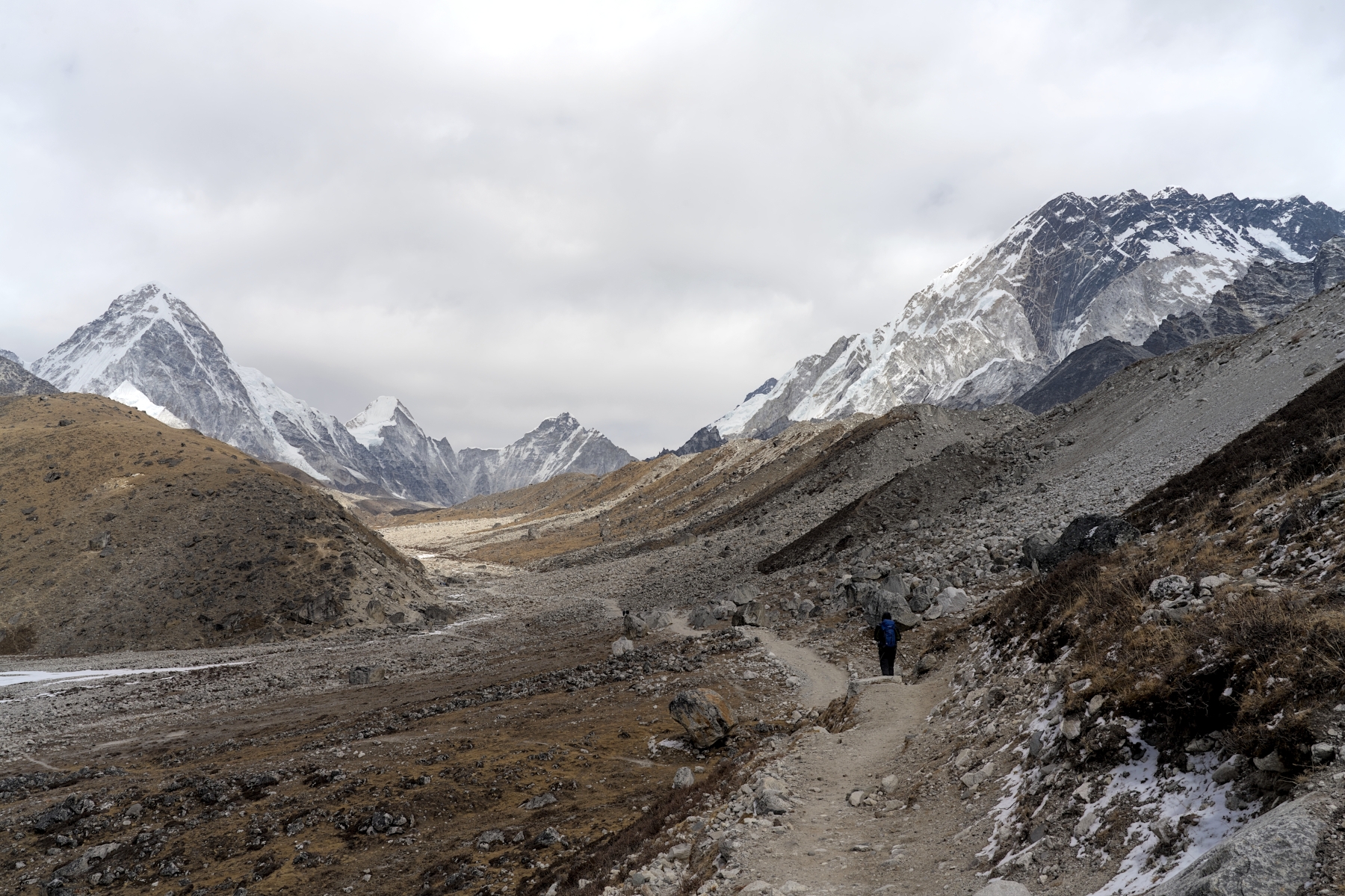
View from trail between Thukla and
Lobuche. From left, Pumori, Lingtren (6,749 m), Khumbutse (6,665 m), and Nuptse
Today is the big day!
After a quick pit stop in Gorak Shep the trek will finally reach EBC in the
early afternoon. But before getting to EBC, there is a great day of hiking to
be had. Not long after leaving Lobuche, to the right of the trail appears a
mass of gray gravel and rock with white and blue snow and ice underneath. This
is the famous Khumbu Glacier, which extends all the way to Everest Base Camp
before turning sharply to the right between Everest and Nuptse, forming the
infamous Khumbu Icefall. But worry not, the trail stays to the left of the
Khumbu Glacier the whole time, so crampons and safety lines won’t be necessary!

View of the Khumbu Glacier (facing
South) from the trail between Lobuche and Gorak Shep
The trail from Lobuche
to Gorak Shep varies, though in general the rise in altitude is quite gradual.
At times the trail will be narrow, hardpack dirt paths crisscrossing valleys
covered in small tufts of yellow moss and grass. At other times the trail will
consist a loose gravel path snaking its way along rolling hills. And at other
times the trail will be quite rocky, ranging from coarse gravel to small
boulders. All the while the amphitheater of mountains surrounding EBC appears in
front, and the Khumbu Glacier and the wall of mountains beyond it to the right.
In terms of the actual hiking trail, the section from Lobuche to Gorak Shep is
arguably the best on the entire trek, given the relatively gentle rise in
elevation, the variety of hiking terrain, and of course the incredible views on
all sides. After a couple hours of the trail reaches Gorak Shep, the final stop
on the trail before Everest Base Camp. Everyone (including the guide and
porters) will drop off their bags and belongings, taking only a small day pack
with them for the final push to EBC.

View of trail to EBC from Gorak
Shep. From left, Khumbutse, Changtse (7,543 m) and the West Shoulder of Everest
The first half of the
trail ranges from gravel-covered, hardpack dirt to loose scree and even some
sections that border on bouldering. Although the trail climbs steadily (EBC is
over 200 meters higher than Gorak Shep), due to the rocky terrain the trail
undulates considerably. The trail goes up, then down, then back up again, all
while twisting and weaving its way between rocks and boulders. After a half
hour or so the trail will straighten out considerably, as you walk along a
rocky ridge that tracks path of the Khumbu Glacier. This section becomes a bit rockier
while continuing to undulate, but it has the added bonus of an unbroken line of
sight to the amphitheater that surrounds EBC, and at times the tip of Mount
Everest itself. Your guide will likely point out the spots where you can see
Everest along this section of trail, but watching those trekking in front of
you and seeing where they stop can also give you hints. 
View from trail to EBC. From left
to right, Changtse, Everest West Shoulder (7,309 m), Everest, and Nuptse (7,861
m),
Eventually the trail
leaves the ridge that it has been following for some time and begins to head
down the ridge in the direction of the Khumbu Icefall. The trail gets really
rocky at this point, with loose scree covering the trail and large boulders on all
sides. At some points there will be a bit of bouldering to do; nothing too
crazy, but be careful where you step because the footing here is not very sound.
As you wind through the boulder field, walking uphill or downhill depending on
the arrangement of the rocks, you will eventually encounter icy crevasses that,
although off the trail, present a real danger to anyone who walks towards the
edge to try and take a look inside. 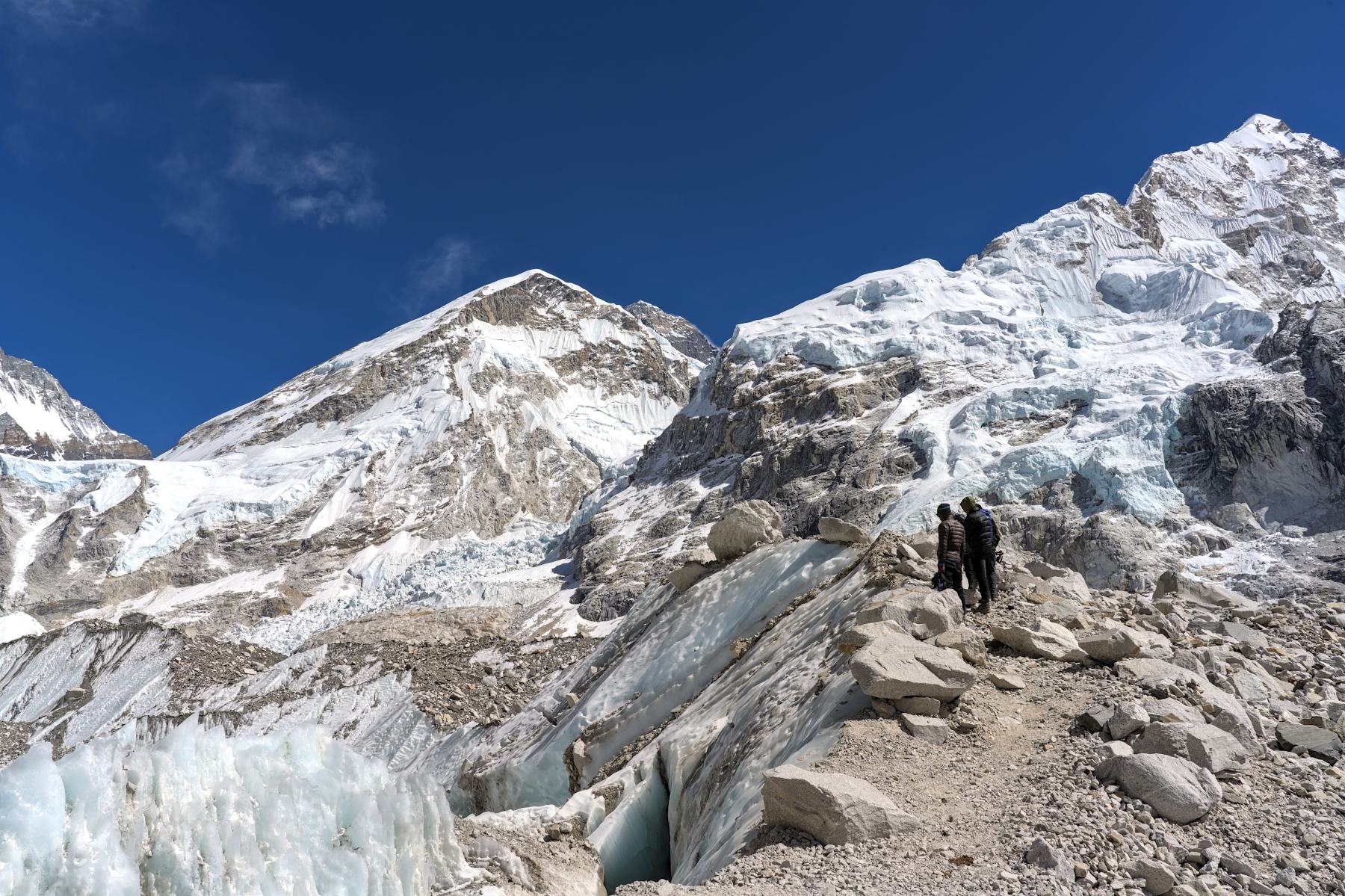
The trail from 30 from base camp.
Icy crevasses below, and Everest, its West Shoulder, and Nuptse above
Depending on the time
of year, your arrival at EBC might be easy to see coming. The closer it gets to
May and November (the two main months for summiting), the more that Base Camp
will be filled with tents, prayer flags, and people. You’ll see the bright
colored tents of EBC from the trail hours before you actually reach it. But if
you go between December and late-February or June and late-August, the
sometimes-ubiquitous tents at EBC are gone, and EBC can sneak up on you. As you
head downhill through a boulder-lined gully, in the direction of Gorak Shep, it
suddenly opens up and looking to your left you can see the infamous EBC rock.
But regardless of the time of year, as soon as you see that rock it finally
hits you: “I’ve made it to Everest Base Camp!”
Now is a time to
celebrate. Take pictures of everything and everyone. Sit under the precariously
perched rock or climb on top of it to have your photo taken. Walk towards the
edge of the Khumbu Icefall and gaze into its vastness. With your eyes, try and follow
the path through which climbers weave their way uphill through the icefall
towards the South Col. Stare in awe at the massive Pumori, Lingtren, Khumbutse,
Changtse, Nuptse, and Everest looming above you. Soak it in, you’ve
accomplished something few others have, and will forever have bragging rights.
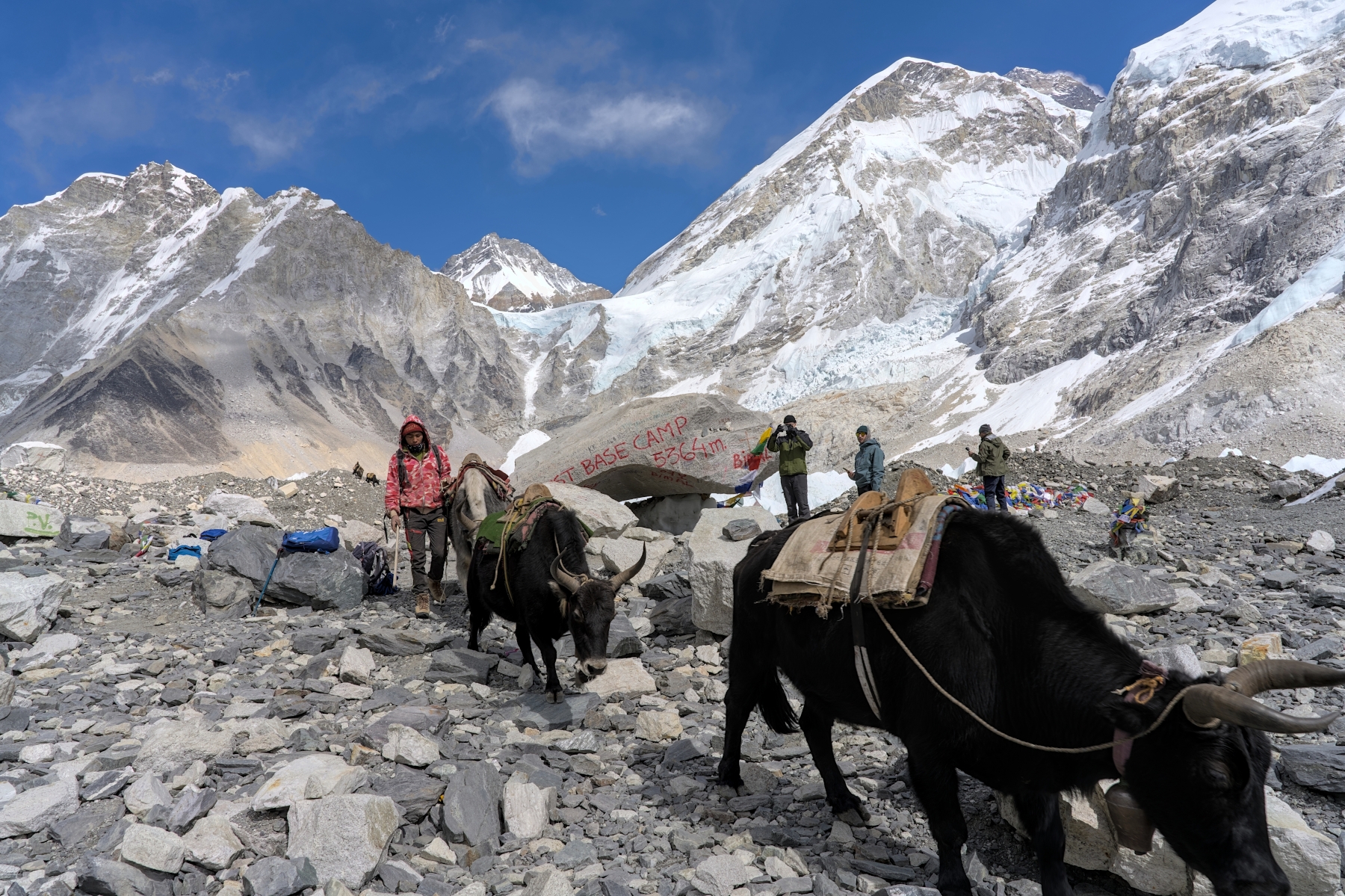
View from EBC. From left:
Khumbutse, Changtse, Everest West Shoulder, Mount Everest (barely visible), Nuptse
After a half hour or so
at EBC, you’ll head back to Gorak Shep along the same path you took to EBC. The
trek back is a bit faster since it is downhill, but none of that will matter.
It’s going to take more than hike back to Gorak Shep to wipe the smile off your
face. Like, for example, waking up at 3:30AM in the dead of night and heading
up a mountain in frigid temperatures. Which is exactly what you will be doing
the next day as you climb Kala Patthar!
If the hike from Tingboche
to Lobuche is the “most beautiful” of the trek and the hike from Lobuche to EBC
is the “most memorable,” the hike up Kala Patthar can be remembered as the “most
cold.” The views of sunrise over Mount Everest are special, but make no mistake
about it, this hike can be uncomfortable. The trek starts anywhere between
4:00AM and 5:00AM and it will be extremely cold at this time. I mean frigid. When
I did this trek in late February, the temperature at 4:00AM was -20 °C (-4 °F), and winds gusts
were around 30 mph. Even after dressing as warmly as possible with two pairs of
wool socks, two base layers of merino wool, a thermal fleece mid-layer top, fleece
pants, down jacket, 2 pairs of gloves, etc., I was still freeing cold when stationary.
The weather won’t be quite so bad in May or September (or during the monsoon
season for that matter), but the temperature will certainly be below freezing
when you start the trek.
View facing south from Kala Patthar
pre-dawn. Gorak Shep at bottom left
The hike up Kala
Patthar is purely optional. If you are tired, cold, or just feel like sleeping
in, you can. Even if you’re with a group, you can stay behind and wait for the
rest of the group to come back from their hike and join them for breakfast. But
if you’re feeling up to it, the trek starts by crossing the large, flat plain behind
the tea houses (the one with the volleyball court) until reaching big hill on
the other side. From there, the trail will snake back and forth up a steep
section of hill via switchbacks until crossing over a ridge. From here, the
trail will become less steep, but it will still be a steady incline. The higher
you walk the colder and windier it will get, and from the top of the ridge it’s
at least another 200 meters of vertical elevation gain. The views are better as
you get higher, but not that much better, so whether it’s worth it to hike all the
way to the top depends on the person. 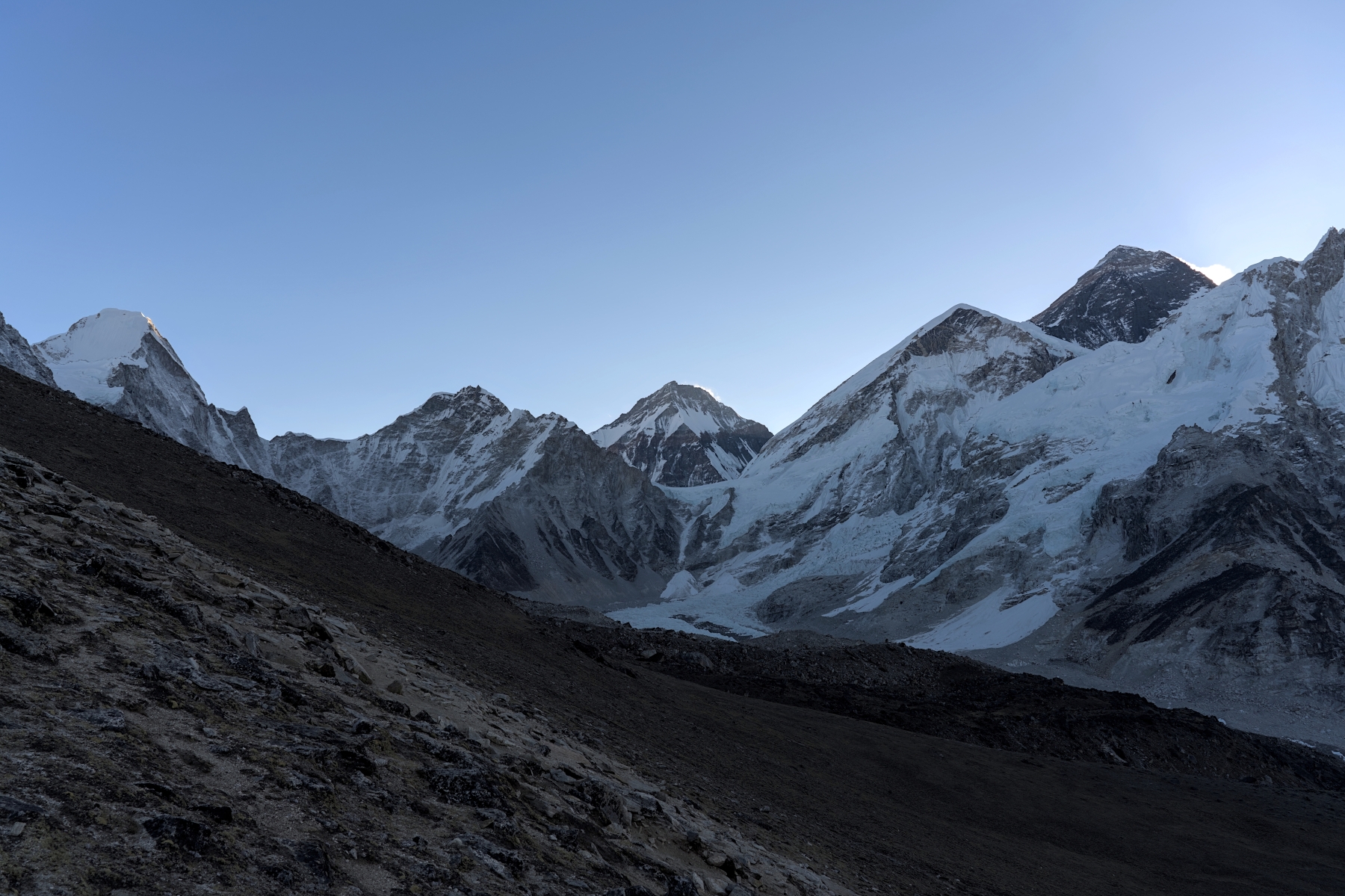
View from halfway up Kala Patthar just
before sunrise. Mount Everest is now clearly visible on the right
However high you decide
to go, you’ll wait and watch the color of the skies and the mountains change as
the sun rises behind Everest. Reds and oranges will turn to purples and pinks,
and eventually blues and greens. The mountains to your west (Pumori, Lingtren,
and others) will look particularly beautiful during this time as the snow on
them lights up in the faint, dawn light. Stay as long as you want (or until you
can’t feel your fingers anymore) before heading back down the hill towards
Gorak Shep for breakfast.
After breakfast, the
trek down the mountain begins, following essentially the exact same route as on
the way up. The hike towards Lobuche follows the same route the day before, and
the trek to the Thukla pass and down to Thukla is also identical. After Thukla,
however, the trek follows a slightly different trail for a bit. Instead of
walking the same path along the hillside towards Dingboche, the trek instead
heads all the way down to the valley floor. There are three reasons for this:
1) once on the valley floor the trail is easier to hike on, 2) it represents a
slight shortcut, and 3) it passes the small settlement of Pheriche that is a possible
stopping point for the day.
The first two points are
pretty self-explanatory. Hiking along the valley floor presents fewer ups and down
and the trail is easier to walk on. And although the shortcut is only 15 minutes
at most, there is no need to go back to Dingboche on the way back down the
mountain, so why do it? This section of the trek is also neat in its own right,
as the mountains that loomed overhead two days earlier look even more
impressive from deep in the valley. In addition, by the time you reach Pheriche
in mid-afternoon the clouds will have rolled in, and when combined with the brush
and grass bespeckling the valley and the quiet stream running through it, will
almost feel like you’re hiking through the Scottish Highlands.

Looking north towards Thukla from just
outside Pheriche
As for the third
reason, being a potential stopping point for the evening, this one requires a
bit of explanation. Unlike the trek up to EBC, when hiking back down from EBC the
altitude and your fitness levels aren’t much of a concern. Your body will have now
spent four nights in a row above 4,400 meters altitude, with the last two being
above 4,900 meters. As a result, your body has acclimated to the altitude by
producing more red blood cells in order to draw more oxygen from the thinner
air. Now that the trek has come back down to 4,400 meters, you have more red
blood cells than necessary for this altitude. This makes it feel as if you are
hooked up to an oxygen tank, making what might normally be tiring feel like a
breeze. By the time you reach Pheriche you will have walked as much as you did
the two days prior, but there is a good chance you won’t feel tired and will be
ready for more trekking. So many hikers skip the stop at Pheriche and continue hiking
down the mountain.
By hiking farther down
the mountain, trekkers can lessen the amount of time they will spend hiking the
following day. One good reason for doing that is it means more time in Namche
Bazar to enjoy food that isn’t dal bhat, have celebratory drinks, play billiards
and darts, and even catch some live music. Also, Pheriche is a small settlement
that exists only for trekkers (and to an extent yak herders depending on the season)
with more basic and more expensive food and accommodation than you’ll find farther
down the mountain in Pangboche. Plus, since Pheriche sits at the bottom of a
deep valley, it can get surprisingly cold and windy there. My recommendation
would be to push on towards Pangboche, but again, the most important thing is
to listen to your body. Wherever you decide to stop for the night, you will
sleep like a baby with all that lovely oxygen coursing through your veins.
Once you leave the Pheriche
Valley, the rest of the hike follows the exact same route it did on the way up
the mountain. Hiking the same ridge past Shomare and Pangboche, across the Imja
Khola Bridge, and back up the hill a bit to Tengboche. At this point in the
morning, the view of the Everest Massif and Ama Dablam should still be clear,
so feel free to stop for a couple minutes to enjoy it. The trek then goes back
down to the river, then back up, following the same ridge towards Namche Bazar.
At this point you will be 2,000 meters lower in elevation than you were a mere
36 hours prior, and will feel like you could run a marathon due to all the
oxygen. And you could continue down to Phakding if you really wanted to,
sleeping in the same place you did the first night of your trek. Some trekkers
do this. But although hiking to Phakding will greatly decrease the trekking distance
the following day, I wouldn’t recommend it. Namche Bazar is a really fun town
when not acclimatizing, and after your accomplishment you deserve to celebrate.
Enjoy yourself!

The final day of the
trek heads back down the hill beneath Namche Bazar, over the Hillary Bridge,
and along the Dudh Kashi River, past Phakding and onwards to Lukla. It is a
long day of hiking in terms of distance, but your body will be a finely-tuned
hiking machine at this point. You’ll arrive in Lukla in the late afternoon,
spending your last night of the trek at a teahouse waiting for your flight the
following morning. This flight is far less scary than the flight here, since
you’ll be getting the difficult part out of the way first before enjoying the
scenery on your way back to Kathmandu (or Ramechhap), so sleep soundly! As your
plane touches down, you’ll grab your bags and head back to your hotel in
Kathmandu, camera full of photos and mind full of incredible memories. And you’ll
realize that just as Mount Everest is the King of the Mountains, you just
completed the King of the Treks.
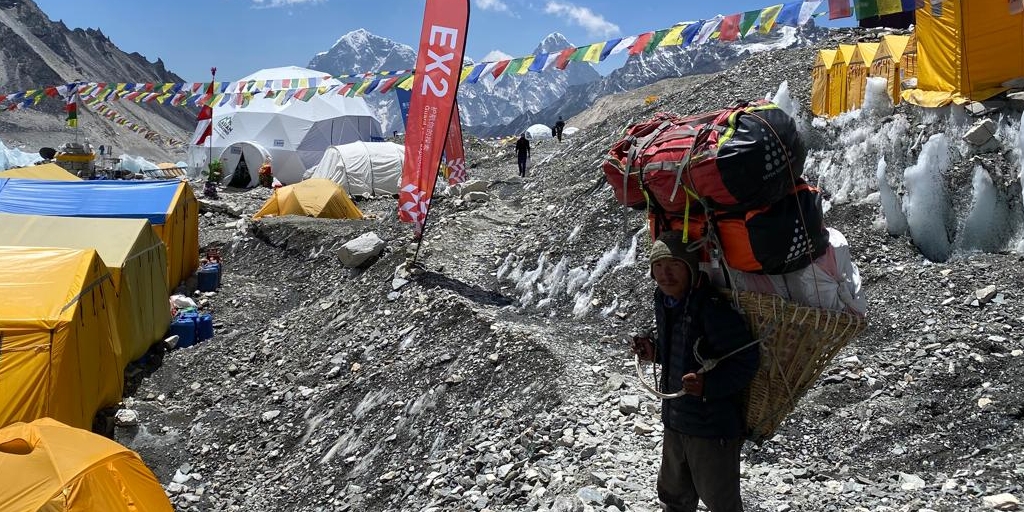
How Can You Reach Everest Base Camp?
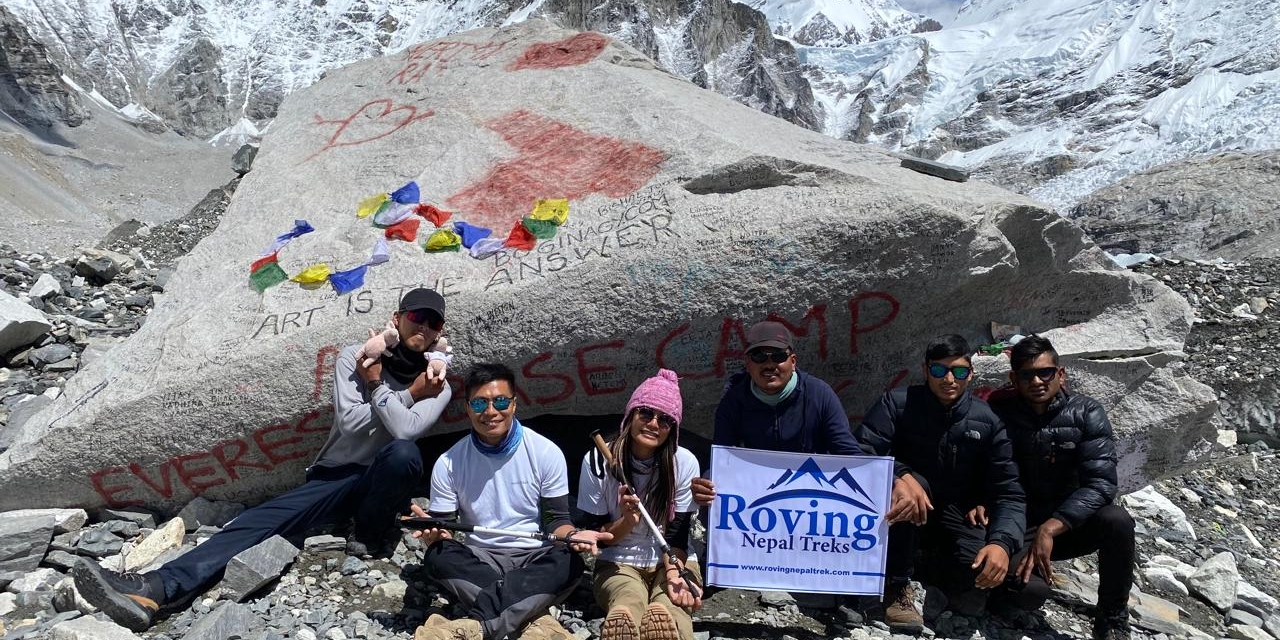
There is hardly any trekker or a common man who wouldn't know about Mount Everest. The charm and grace of Mount Everest sit right at the top. Talkin...
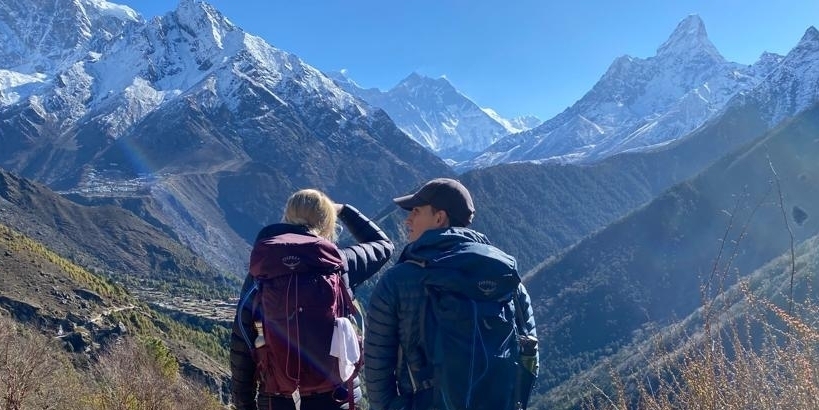
The items to pack for the trek might differ from person to person and even the trekking agency. Some common items need to be included wherever you a...
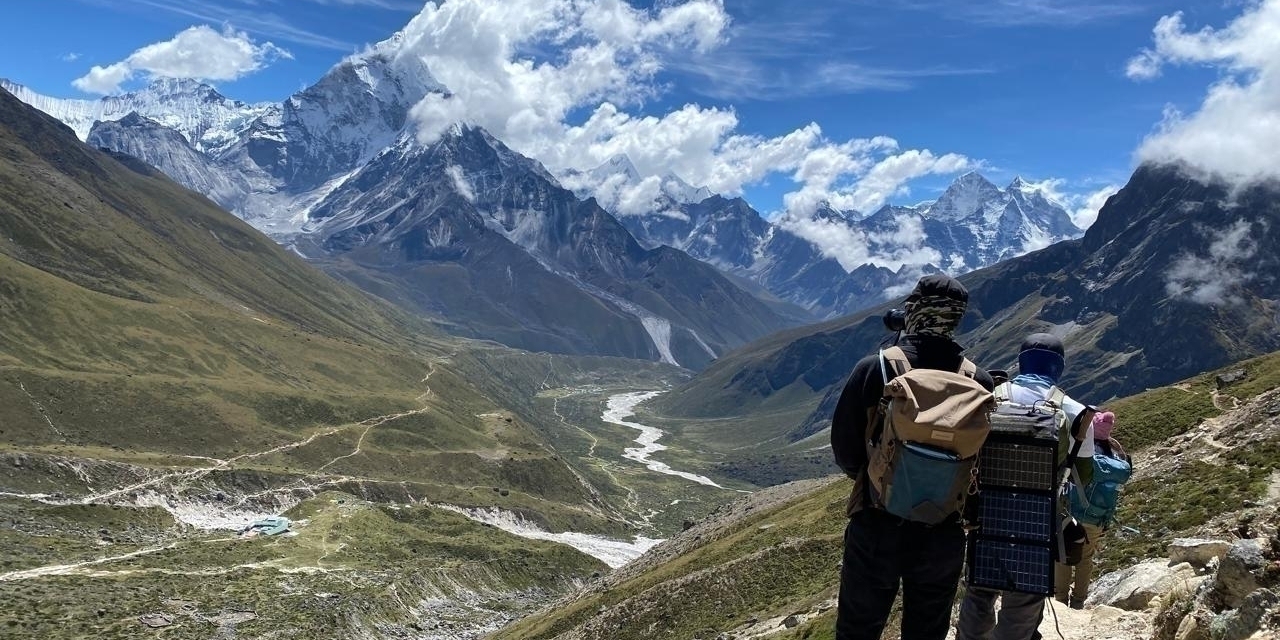
If you are planning to go trek to Everest Base Camp, this thorough set of Everest Base Camp Trek FAQs answers your every question.
